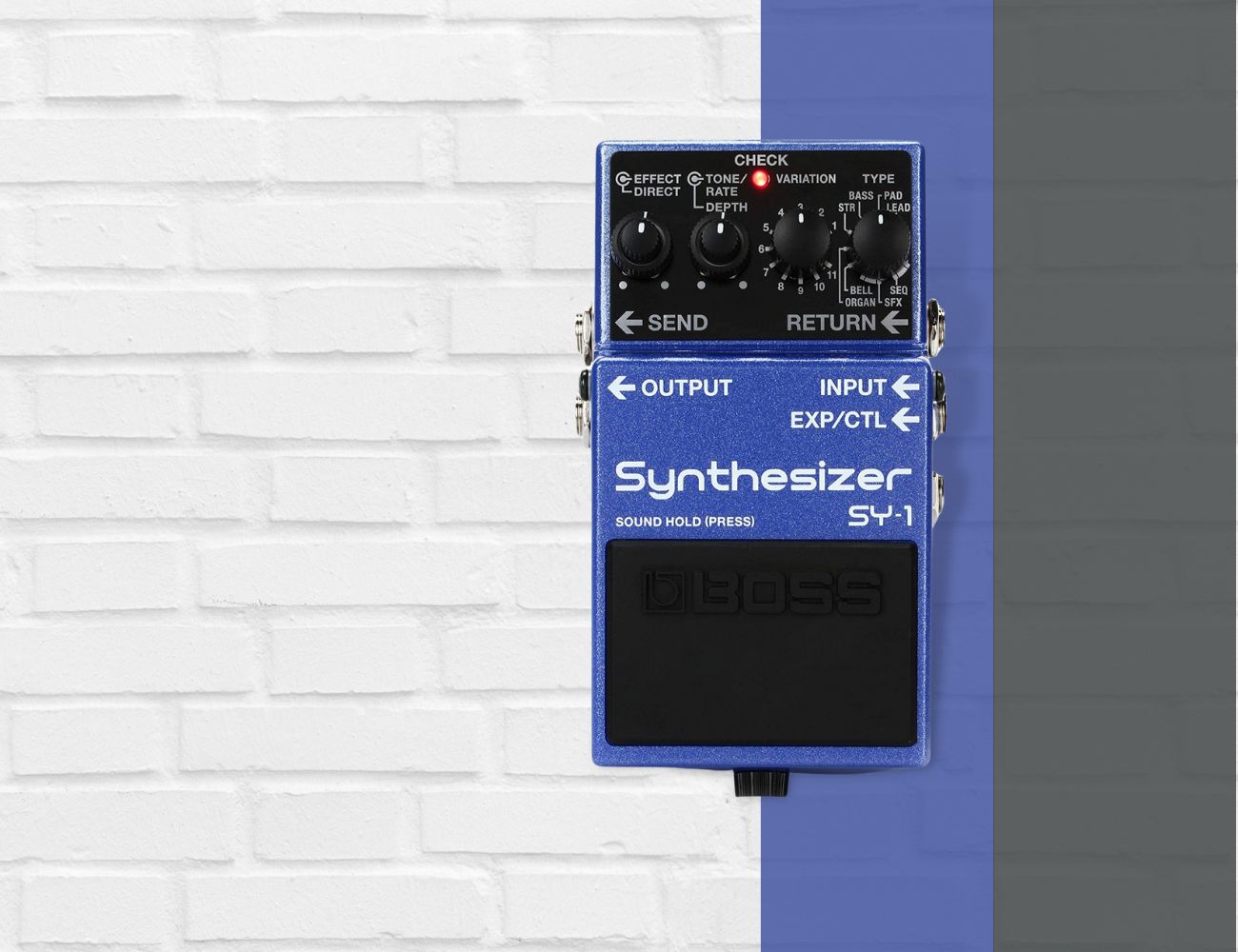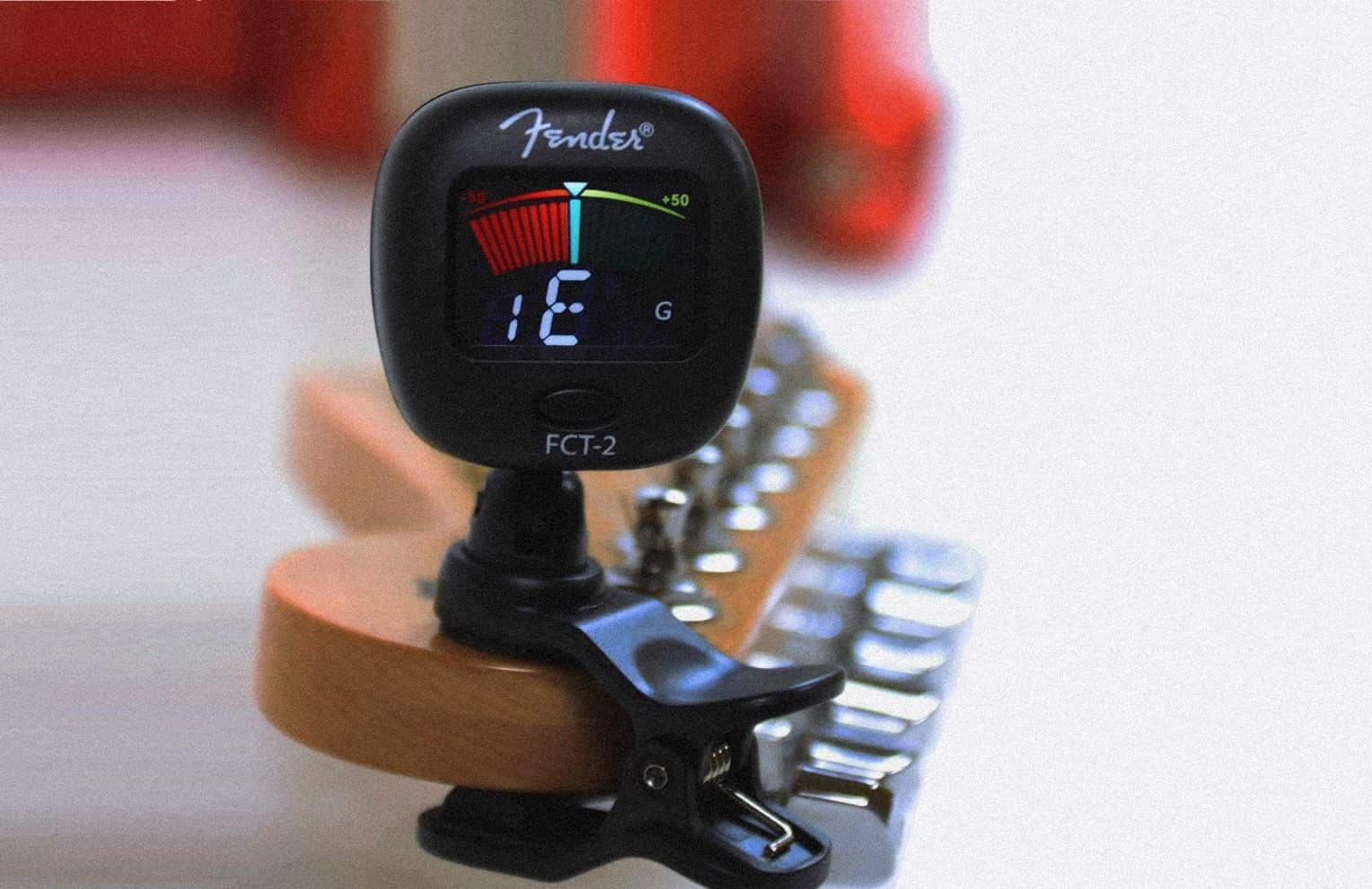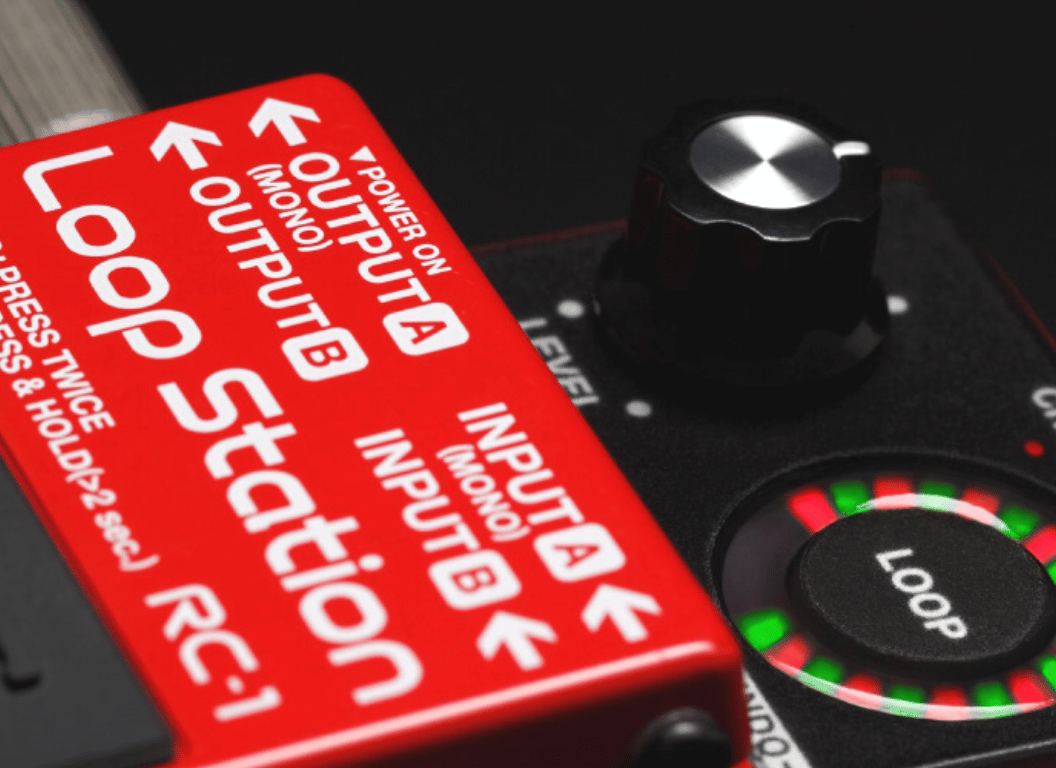In the realm of guitar music, synth pedals have revolutionized the way musicians shape their sound.
From humble monophonic analog models to advanced polyphonic digital devices, the evolution of these tools has broadened the sonic palette for guitarists worldwide.
However, this diverse range can make choosing the right synth pedal a challenge, even for seasoned professionals.
This article aims to simplify your decision-making process by offering an in-depth review of the best guitar synth pedals.
I will highlight their unique features, evaluate their pricing, and discuss the distinct tonal possibilities they bring to your guitar rig.
Table of Contents
- Best Synth Pedals
- Boss SY-1 Guitar Synthesizer Pedal
- Seymour Duncan Fooz Analog Fuzz Synthesizer Pedal
- Roland GR-55GK Guitar Synthesizer
- MOOER E7 Polyphonic Guitar Mini Synth Pedal
- Boss SY-1000 Guitar Synthesizer Pedal
- Panda Audio Future Impact Bass/Guitar Synth Pedal
- Source Audio One Series Ultrawave Multiband Guitar Processor Pedal
- MOOER GE300 Multi Effects Guitar Synth Pedal
- Source Audio C4 Synth Pedal
- Boss SY-200 Guitar Synthesizer Pedal
- EarthQuaker Devices Bit Commander Guitar SynthPedal
- Aural Dream Gamba Tone Synthesizer Guitar Effect Pedal
- Empress Effects ZOIA Modular Synthesizer Pedal
- Keeley Synth-1 Fuzz Wave Generator Pedal
- Pigtronix Mothership 2 Analog Synthesizer Pedal
- DOD Sub-Synth Guitar Effects Pedal
- TC-Helicon Talkbox Synth Pedal
- Pigtronix Space Rip Synth Pedal
- EarthQuaker Devices Data Corrupter Pedal
- Boss SY-300 Advanced Guitar Synth
- What exactly is a synth pedal?
- What to consider when choosing a synth pedal?
- How to properly use a synth pedal?
- How to order pedals on a pedalboard?
- Boutique vs. Mass-Produced pedals
- How much should you spend on a guitar pedal?
- Can you use a guitar pedal with a bass guitar?
- How to properly power your pedals?
Best Synth Pedals
Before I begin, here are my top selected choices:
Roland GR-55GK Guitar Synthesizer

Revolutionary fusion of guitar synthesis and modeling, hundreds of ready-to-use sounds. Check Price
|
|
Aural Dream Gamba Tone Synthesizer Guitar Effect Pedal

Authentic Gamba tones with True Bypass and vibrato module. Check Price
|
Boss SY-1 Guitar Synthesizer Pedal
Legendary BOSS quality for guitar/bass effects and synthesis.
BOSS offers reliable, high-quality gear for guitarists of all levels. Their products are designed to deliver exceptional tone, ruggedness, and reliability, perfect for all types of playing.
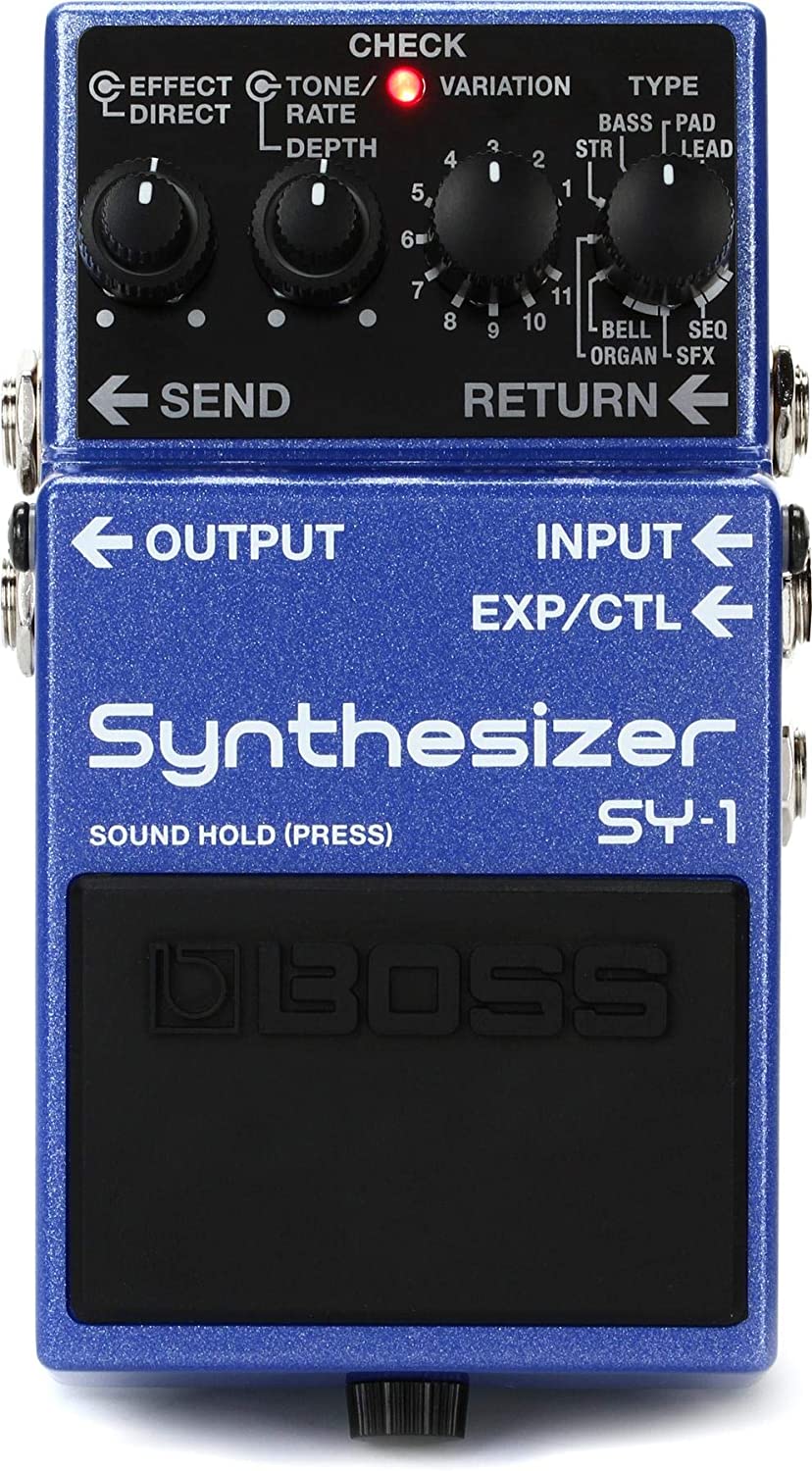
If you’re a guitarist or bassist looking to explore new sonic territories, you might want to consider the Boss SY-1.
This compact pedal is a powerhouse of synth sounds packed into a size that won’t crowd your pedalboard.
What’s cool is that you don’t need any special pickup to use it.
Just plug in your instrument, and you’re good to go.
With the SY-1, you get a whopping 121 sounds to play with.
We’re talking about everything from punchy leads and deep basses to layered organs and sweeping pads.
And the best part? You don’t need to be a programming whiz to use it.
All the sounds are ready to go right out of the box.
One thing that stands out about the SY-1 is its latency-free performance.
This means you can express yourself musically without any delay.
Plus, it’s got a send/return loop for integrating with other pedals and supports external control via a footswitch or expression pedal.
Just remember, it operates on a standard Boss 9-volt DC power supply.
- My Review
Right off the bat, I was taken by its compact size.
It’s a real space-saver on the pedalboard, yet it doesn’t compromise the range of sounds it offers.
With this little gadget, I could explore a vast sonic landscape, from punchy leads to deep basses and even layered organs.
It’s like having a whole synth orchestra at my fingertips.
One thing that stood out was the ease of use—no need for a special pickup or programming knowledge.
I just plugged in my guitar, and I was ready to rock.
With 121 sounds to choose from, I spent hours experimenting and creating new music.
It’s a real game-changer for musicians looking to push their creative boundaries.
Now, let’s talk about performance.
I was pleasantly surprised by the latency-free playing experience.
It’s so responsive that it felt like an extension of my instrument, allowing me to express myself freely without any delay.
Integration with other pedals was a breeze, thanks to the send/return loop.
And the support for external control via a footswitch or expression pedal gave me even more flexibility in shaping my sound.
However, it’s not all sunshine and rainbows.
The SY-1 operates on a standard Boss 9-volt DC power supply, so you’ll need one handy.
And while the price point might be a bit steep for some, I believe the wealth of features and the quality of sounds it offers make it a worthy investment.
In my book, the Boss SY-1 is a fantastic tool for any musician looking to add a new dimension to their sound.
Here are the ratings I’ll give to the Boss SY-1 Guitar Synthesizer Pedal:
It’s versatile, user-friendly, and packed with features that inspire creativity.
It’s not just a pedal; it’s a whole new world of sonic possibilities.
- Pros:
- Compact, pedalboard-friendly size.
- No special pickup required.
- 121 total sounds available.
- Cons:
- Requires 9-volt DC power supply.
- May require additional pedals for control.
- Price may be high for some users.
My final verdict is that the Boss SY-1 Guitar Synthesizer Pedal is a remarkable piece of equipment that any musician would find valuable.
Its versatility, rich features, and high-quality tones make it a standout choice.
The latency-free performance and the brand’s reputation further add to its appeal.
While the price might be steep for some, the wealth of creative possibilities it offers makes it a worthy investment.
It’s not just a pedal; it’s a gateway to a new world of sonic exploration.
Seymour Duncan Fooz Analog Fuzz Synthesizer Pedal
Highly customizable LFO and an envelope follower for modulation.
The Seymour Duncan FOOZ Analog Fuzz Synthesizer offers a unique combination of fuzz, filter, LFO, and envelope follower, letting you tap into classic synth sounds and more. With assignable expression input and assignable envelope follower, you can create rich, complex tones from your guitar.
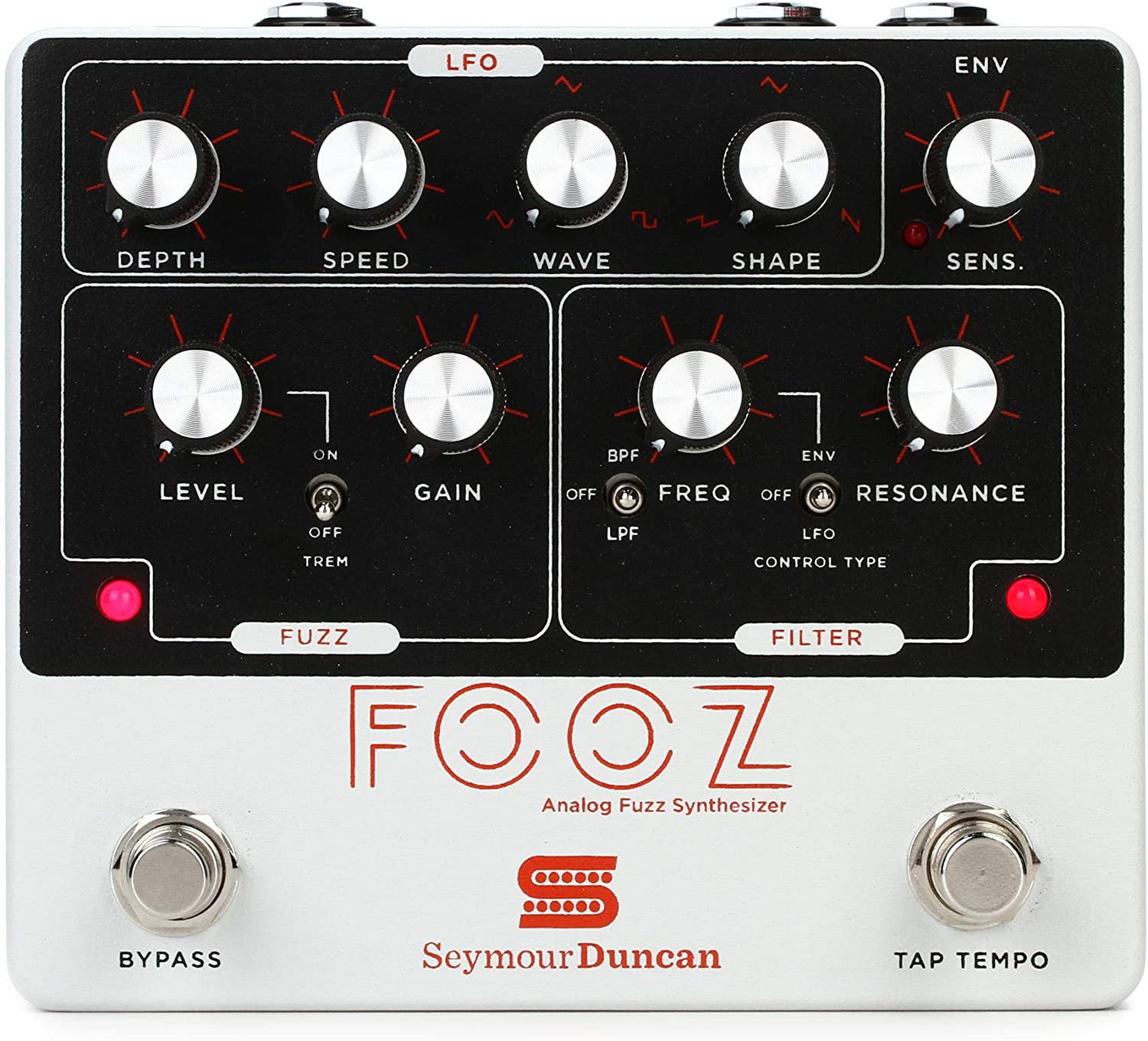
The Seymour Duncan Fooz is an analog fuzz synthesizer pedal designed to bring the spirit of synth creativity to your guitar.
With its true bypass power, this piece of gear can be run off an internal 9V battery or an external 9V-18V regulated power supply.
It has a rich, saturated square-wave fuzz that works to morph your guitar into the ‘oscillator,’ setting the stage for some serious sound sculpting.
Among its many features, there’s a versatile filter that you can set to a low pass (classic synth style) or bandpass (more like a Wah pedal).
It also has a highly customizable LFO and an envelope follower for modulation.
You can use the LFO to control volume and filter frequency, while the envelope can manage the filter and the LFO’s depth and rate.
There’s more! The Fooz pedal allows an external expression pedal to control its surface features.
You can use this pedal in various ways to mimic synth sounds and as a straight-up fuzz, tremolo, auto-wah, and more.
With its white color and dimensions of 5 x 5 x 5 inches, it’s quite a compact and stylish addition to your setup.
Plus, at just 0.77 kilograms, it won’t add much weight to your gear bag.
It’s truly a multifunctional tool with many possibilities for sound exploration.
- My Review
From the moment I plugged my guitar into the Seymour Duncan Fooz Analog Fuzz Synthesizer Pedal, I felt an immediate surge of creativity.
This isn’t just another effects pedal—it’s a full-fledged analog synth packed into a compact, stylish white box.
The heart of the Fooz is its saturated square-wave fuzz.
Plugging in, I found that my guitar transformed into a pseudo-oscillator, a source of raw sound to be shaped by the pedal’s other components.
This alone makes for a pretty impressive fuzz tone.
A versatile filter is available next in the signal chain.
I could select between a Low Pass Filter (more synth-like) and a Band Pass Filter (similar to a Wah pedal).
Combined with the fuzz, this filter already opens up a vast terrain of sound.
What elevates the Fooz, though, is its modulation section.
It’s equipped with a deeply customizable LFO and an Envelope follower.
These can be used to modulate the volume, filter frequency, and even the depth and rate of the LFO itself.
The possibilities seemed nearly endless.
An external expression pedal can be hooked up for even more control.
I was delighted to find that it can control most of the pedal’s surface controls, offering an even wider palette of sounds.
The Fooz is more than just a fuzz or synth pedal.
Depending on the settings, it’s also a capable tremolo, auto-wah, and even a rhythmic filter or cocked wah.
At 0.77 kilograms and 5x5x5 inches, it packs a lot of functionality into a small, portable package.
Despite its versatility, it’s worth mentioning that the Fooz requires some time to understand and explore fully.
Here are the ratings I’ll give to the Seymour Duncan Fooz Analog Fuzz Synthesizer Pedal:
But for those willing to dive in, it’s a veritable playground of sound.
The Seymour Duncan Fooz Analog Fuzz Synthesizer Pedal isn’t just a pedal; it’s an invitation to redefine what’s possible with your guitar.
- Pros:
- Versatile synthesis capabilities.
- Authentic vintage analog delay tones.
- Interactivity and tactile feeling.
- Cons:
- Limited preset options.
- Potential signal noise at higher settings.
- Relatively higher price compared to similar pedals.
My final verdict is that the Seymour Duncan Fooz Analog Fuzz Synthesizer Pedal is a highly versatile and feature-rich pedal that delivers authentic vintage analog delay tones and offers many creative possibilities.
Its interactivity and tactile feeling bring the spirit of synth creativity to guitar playing.
The pedal performs well, backed by the reputable Seymour Duncan brand.
Although the value may vary for individuals depending on their specific needs and budget, overall, the Fooz pedal offers a compelling package for musicians seeking unique and expressive fuzz synthesis capabilities.
Roland GR-55GK Guitar Synthesizer
Revolutionary fusion of guitar synthesis and modeling, hundreds of ready-to-use sounds.
Roland GR-55GK-BK is a revolutionary guitar synthesizer with fast pitch-detection technology, triple-core generator, and hundreds of ready-to-use sounds for rock and pop guitarists. It offers instant access to a rich library of sounds from pop to rock and beyond.
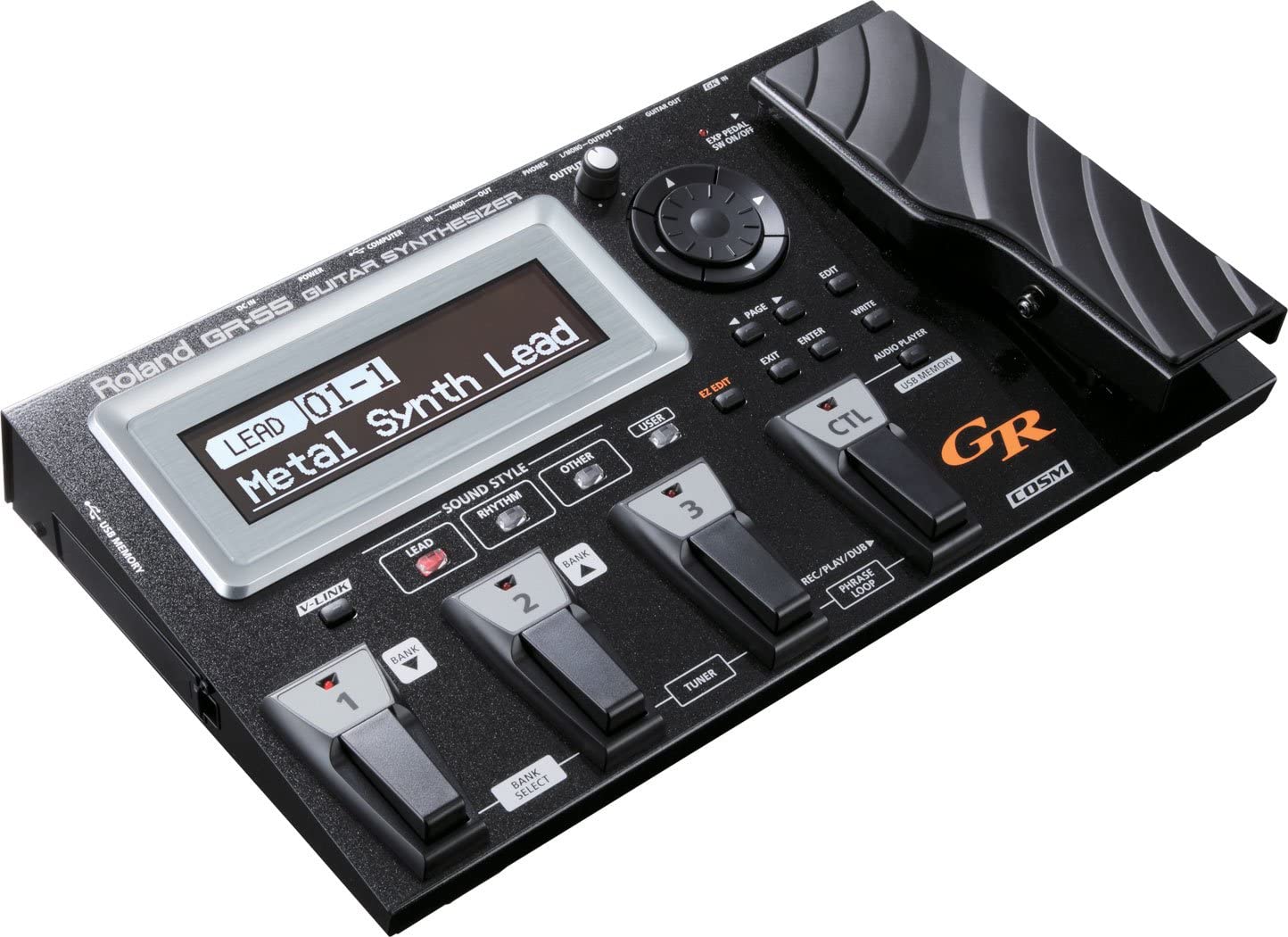
Enter a new era in guitar synthesis with the Roland GR-55GK, a product that seamlessly blends top-notch COSM guitar modeling and synthesis.
This innovative device can handle four sound sources simultaneously, with two dedicated to PCM Synth tones, one to COSM guitar modeling, and one for normal guitar input.
Its user-friendly interface makes it a breeze to navigate through hundreds of pre-set sounds, perfect for both rock and pop guitarists.
The GR-55GK is powered by Roland’s advanced technology, ensuring superior sound quality and ultra-fast processing.
Its sound library boasts over 900 editable PCM sounds, encompassing everything from pianos, organs, and strings to vintage synths.
This guitar synthesizer doesn’t just reproduce sounds; it creates a symphony of tones and textures you’ve never heard before.
Its item dimensions are 24x14x6 inches, and it weighs around 5000 grams.
In terms of aesthetics, it sports a striking multicolor design.
- My Review
Roland’s GR-55GK Guitar Synthesizer is a piece of technology that pushes the envelope regarding guitar synthesis.
Right out of the box, I was struck by the vast array of sounds at my disposal.
This unit showcases the guitar’s versatility, allowing me to switch from vintage synth tones to realistic piano sounds with a mere touch of a button.
I found the sound quality exceptional, thanks to Roland’s cutting-edge technology.
The processing speed is lightning-fast, a plus for performers who must change tones quickly in a live setting.
Yet, it’s important to note that this lightning speed comes with a catch.
I noticed some latency issues, especially with piano sounds, which might be a deal-breaker for some.
One highlight of the GR-55GK is its ability to handle four sound sources simultaneously.
This feature provides an unparalleled layer of depth to my soundscapes.
However, I found this can also lead to unwanted noises, like ghost notes and artifacts.
It’s a bit of a double-edged sword. Now, onto the usability.
I appreciate the user-friendly interface, which simplifies navigating through the hundreds of pre-set sounds.
But the set-up process? That’s a different story.
It wasn’t as easy as plug-and-play.
I had to carefully set up the GR-55 and GK3 pickup to avoid tracking issues.
It was time-consuming, but once set up correctly, it performed admirably.
It’s also worth noting that the GR- overall design is appealing, with its multicolor layout.
However, some components, like the GK-3 pickup, felt cheaply assembled.
Here are the ratings I’ll give to the Roland GR-55GK Guitar Synthesizer:
Despite these minor setbacks, I must say that the Roland GR-55GK Guitar Synthesizer is a game-changer.
It’s not perfect, but it’s an impressive tool that offers a new dimension to my guitar performances.
- Pros:
- Exceptional versatility and programmability.
- Hundreds of great, ready-to-use sounds.
- Realistic PCM and COSM synthesis capabilities.
- Wide range of effects and amp modeling.
- Ability to create custom patches and presets.
- Cons:
- Potential reliability issues with the unit.
- Some users experienced tracking and latency problems.
- Initial setup and customization can be time-consuming.
My final verdict is that the Roland GR-55GK Guitar Synthesizer with GK-3 Pickup is a highly versatile and feature-rich product that offers a wide range of sounds and effects for guitarists.
Its innovative synthesis technology and extensive customization options are powerful tools for creating unique and expressive music.
While there may be some potential reliability issues and initial setup complexities, this product’s overall performance and value make it a worthy choice for those seeking to explore new sonic possibilities.
MOOER E7 Polyphonic Guitar Mini Synth Pedal
Transform guitar with 7 synthesizer tones, arpeggiator, and 7 preset slots.
transforms an electric guitar into a synth with 7 brand-new synth tones and an individual arpeggiator, all housed in a mini-sized pedal for easy integration into any guitar rig. Save up to 7 presets for easy recall, and use the LED indicators to quickly switch between tones.
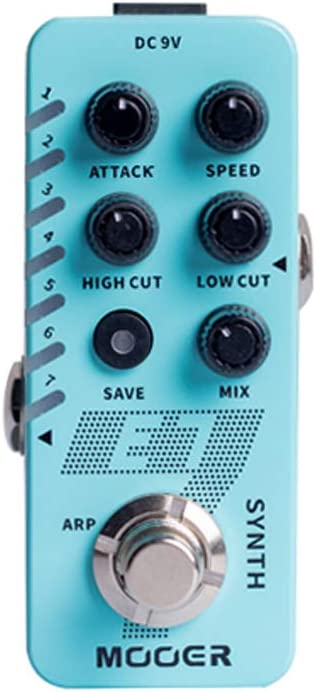
Let me introduce you to the MOOER E7 Polyphonic Guitar Mini Synth Pedal.
This compact powerhouse comes packed with seven distinct synth sounds.
You can choose trumpet, organ, sea wave, well, saw wave, 8-bits, and EDM pad, each offering a unique auditory experience.
But what makes it even more interesting is the individual arpeggiator that comes with each sound.
The E7 isn’t just about providing variety, though.
It allows you to tweak and fine-tune the sounds to your liking.
There are controls for adjusting the attack, speed, high cut, and low cut.
You also get a mix control and a save button to preserve the settings for each of the seven synths ‘banks.’
As part of MOOER’s Micro series, the E7 is intuitive and user-friendly.
It has LED lights that indicate the chosen patch, making it simple for you to edit the parameters of your choice.
And when it’s time for an update, the pedal has a USB port for firmware updates, ensuring your tool remains at the top of its game.
This pedal is more than just a synth effects pedal; it’s a tool that gives you an orchestra of sounds at the stomp of a foot.
- My Review
Having played around with the MOOER E7 Polyphonic Guitar Synth Pedal, I must say that it’s quite a remarkable piece of gear.
It’s truly impressive how it packs so much functionality into such a compact unit.
The pedal’s seven unique synth sounds offer a diverse range of tonal possibilities, and the built-in arpeggiator adds another layer of versatility to your performances.
The high and low cut controls provide precision in shaping your sound, and the ability to save settings for each synth ‘bank’ is a real-time-saver.
What I found particularly interesting is that how you play your guitar greatly influences the outcome of the synth sounds.
The pedal excels at mirroring chord progressions and fast lines, even effectively following bends and vibrato.
It truly shines when used to double bass lines, riffs, or melody lines with a synth-like articulation.
However, trying to mimic iconic synth lead lines from various eras produced somewhat different results, which isn’t necessarily bad – it’s simply a testament to the pedal’s unique character.
The MOOER E7 is about the sounds it can produce and its practical design.
Its small footprint is perfect for those who need to conserve space on their pedalboard, and it’s also budget-friendly, making these incredible synth textures more accessible to guitarists.
It’s impressive to see how far technology has come to allow such a product to exist without requiring any modifications to the guitar, such as installing a synth pickup.
The overall build quality of the pedal is commendable.
Here are the ratings I’ll give to the MOOER E7 Polyphonic Guitar Mini Synth Pedal:
The switch cover, for instance, is a thoughtful addition that makes the pedal more visible on the board and safer to stomp on without toppling it over.
Please note that it requires a 9-volt power unit, which isn’t included.
- Pros:
- Compact size.
- Versatile synth tones.
- Individual arpeggiator for each tone.
- 7 preset slots for storing user presets.
- Cons:
- Limited number of sounds (7).
- Some synth sounds may be unusable.
- Noisy/hum issues reported by some users.
My final verdict is that the MOOER E7 Polyphonic Guitar Synth Mini Synth Pedal offers decent versatility and features with its seven synth tones, individual arpeggiators, and preset slots.
However, some users have reported issues with certain synth sounds, noise/hum problems, and limited sound options.
Considering its brand reputation and value for the price, it may be a suitable choice for those looking to experiment with synth sounds on a budget.
Boss SY-1000 Guitar Synthesizer Pedal
Limitless sound design with cutting-edge processing and GK technology.
The SY-1000 guitar/bass synth transforms your rig with limitless sound design options, combining cutting-edge sound engine, DSP, and evolved GK technology for the best performance and organic playing experience. Create intense analog-style leads, warm pads, modeled electric/acoustic tones, or all at once with freely configurable footswitches, outputs, and external controls.
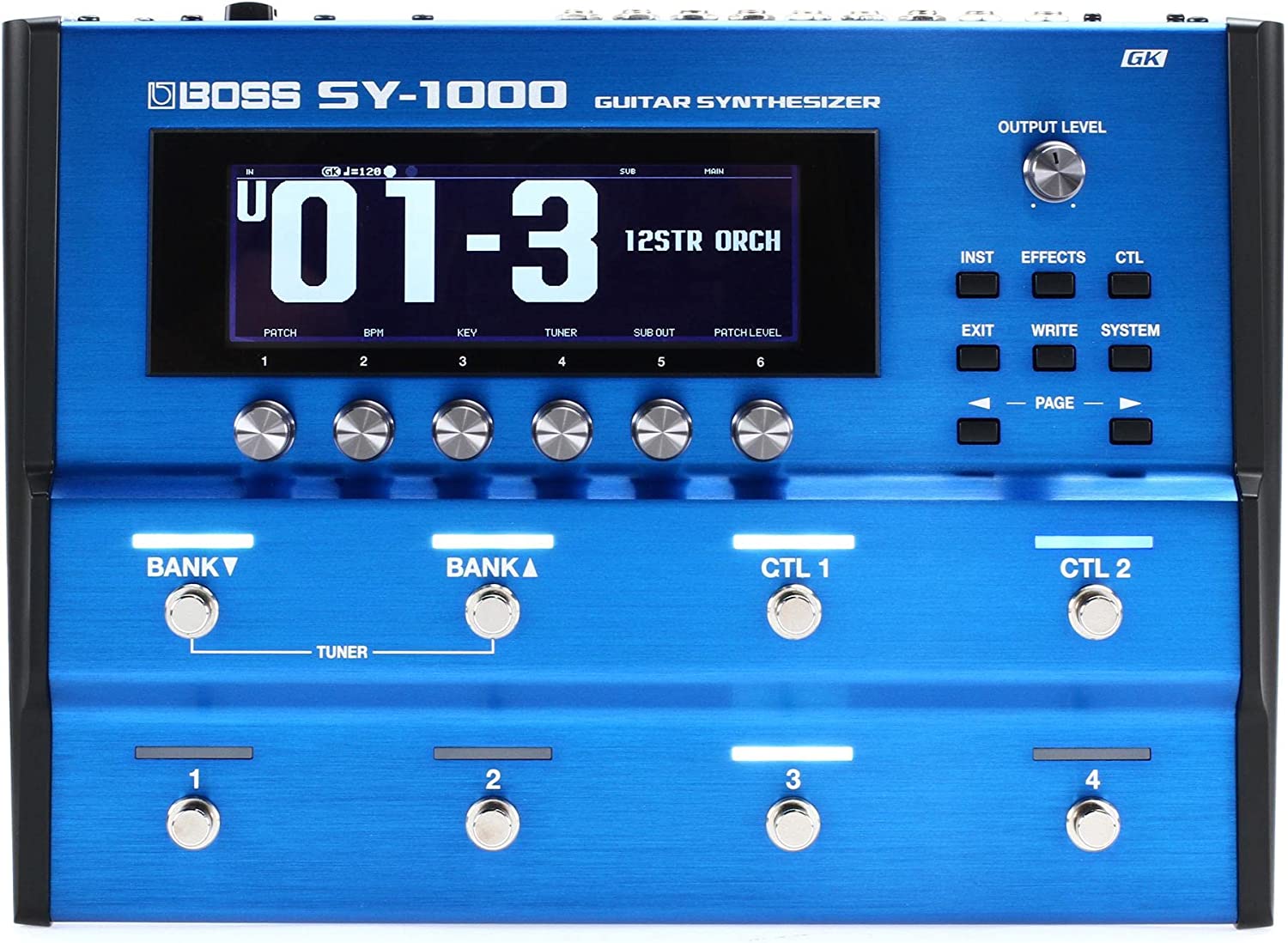
Highlighting an innovation in guitar synthesizer pedals, we present the Boss SY-1000.
It’s designed for bass and electric guitars with a 1/4″ instrument input.
It has eight footswitches that can be assigned to different functions addressing various user preferences.
The pedal also has a 13-pin GK Interface and an effects loop feature.
With dimensions of roughly 20 x 13 x 5.35 inches and weighing around 7.6 pounds, this product is pretty easy to handle and adds minimal weight to a musician’s kit.
Among all its features, the SY-1000 stands out because it can transform your typical guitar setup into a boundless sound design option.
Able to produce an array of sounds, models for both acoustics and electrics, and different synth tones simultaneously, this Boss product offers a broad range of capabilities.
- My Review
Diving into the features of the Boss SY-1000 Guitar Synthesizer Pedal, it’s evident that this little blue powerhouse is truly a beast in its field.
When I plugged it in for the first time, I was blown away by the endless sound design possibilities.
The transformation it invites your rig to undergo is in a league of its own.
You can experiment with intense leads, warm pads, or moving synth textures by browsing through the immersive and diverse set of acoustic, bass tones, and expressive effects.
Pairing these with my distinct playing style felt organic due to the cutting-edge, high-octane DSP integration.
Offering three simultaneous instruments and fantastic processing, it felt like holding infinity in the palm of my hand.
One thing I found quite fascinating is the powerhouse configuration.
It allows for footswitches, outputs, and external controls.
It effortlessly complements any workflow, making it not just user-friendly but user-interactive.
This was, however, countered by the complicated setup process, with almost no documentation to guide a beginner through.
When I explored the device further, I was spellbound by its multi-instrument emulation capability, which is simply unparalleled.
However, I was slightly disappointed by the lack of specific effects like “shimmer” and “tera echo.” Also, using synthesized sounds with the jack normal of the guitar seemed limited, a feature that could use some improvement.
Despite these minor shortcomings, one can not overlook its groundbreaking contribution to the world of sound guitar design.
Here are the ratings I’ll give to the Boss SY-1000 Guitar Synthesizer Pedal:
Even though it’s a bit high on the price, the unique sound experiences it offers make it a valuable asset in your musical journey.
The Boss SY-1000 is an inspiring creativity machine, its vast sonic abilities and deep expressiveness breathing life into every note you play.
- Pros:
- Vast, diverse sound design options.
- Three simultaneous instrument operations.
- Configurable hardware for diverse workflows.
- Cons:
- No effective operational manual or guidelines.
- Lacks some types of specific effects.
- Limited synthesized sound usage with jack normal.
My final verdict is that the Boss SY-1000 Guitar Synthesizer Pedal, despite a few shortcomings, is a revolutionary product that provides an array of sound design options and is well worth the investment for its exceptional versatility, features, and performance.
Panda Audio Future Impact Bass/Guitar Synth Pedal
Lightning-fast pitch tracking, virtual analog sound engine, deep sound editing.
Future Impact v3 is a powerful virtual analog synth with lightning-fast pitch tracking and extensive sound-shaping capabilities. With its four oscillators, two filters, and PC/Mac editor software, it can create a wide range of iconic and modern electronic sounds.
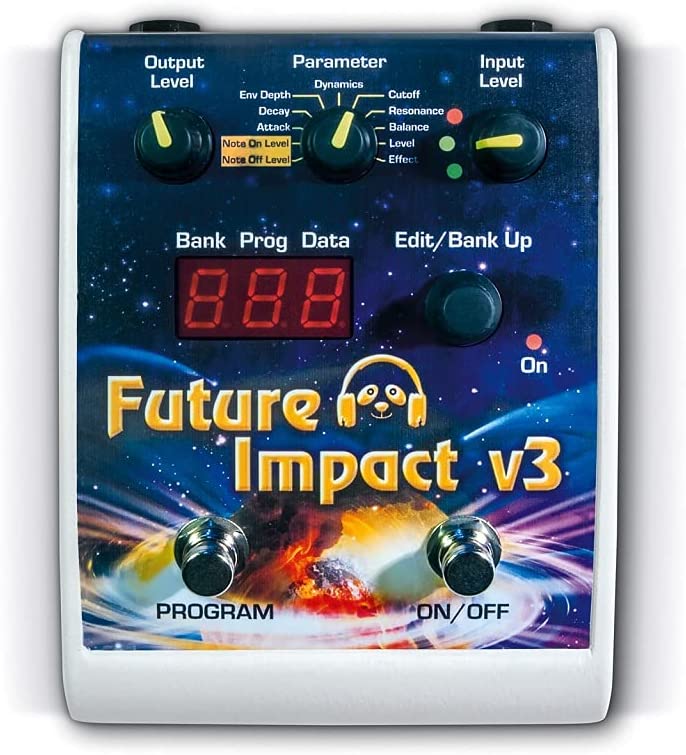
The Panda Audio Future Impact v3 stands out in Bass/Guitar Synth Effects Pedals, boasting an exceptional pitch tracking system.
This system is renowned for its speed, even when delving into the deepest octaves, making it a standout choice for musicians.
Sporting a colorful exterior, this pedal isn’t just about aesthetics.
It is compact and lightweight, measuring just over 3 by 5 by 6 inches and weighing in at a mere 0.6 kilograms.
It’s not only the pedal’s exterior that impresses.
Inside, a virtual analog sound engine brings your instrument to life in ways you never thought possible.
This pedal has got you covered whether you’re after aggressive synth basses reminiscent of Mini-style or aiming for acid bleeps, flutes, organs, or synth leads.
It opens up the entire spectrum of electronic music history right at your feet.
Each sound is fully customizable, with 11 different parameters to tweak.
You can mold your sound with the accompanying PC/Mac editor software, giving you an extra control layer.
Notably, this pedal runs on just 100 milliamps, making it an energy-efficient choice for musicians.
- My Review
Taking the Panda Audio Future Impact v3 Bass/Guitar Synth Effects Pedal for a spin, I was immediately struck by the speed of its pitch-tracking system.
It was like lightning had been captured in a bottle, even when I ventured into the deepest octaves.
This thing didn’t miss a beat. Admittedly, the pedal’s exterior left me intrigued.
It was flamboyantly multicolored yet compact and lightweight, fitting snugly on my pedalboard without issue.
At a glance, it was clear that the pedal’s design wasn’t only about looking good and being practical.
As I began experimenting with the pedal’s sound capabilities, I was taken aback by its sheer range.
From the aggressive synth basses that hearken back to Mini-style sounds to the acid bleeps, flutes, organs, and synth leads, I felt like I had an entire electronic music history timeline under my foot.
It was an auditory journey I hadn’t expected.
Diving deeper, I discovered the ability to tweak 11 different parameters for each sound.
It was a level of customization that appealed to the artist in me.
The PC/Mac editor software was a game-changer, allowing me to fine-tune my sound to the finest detail.
Despite all its features and functionalities, I did find one little snag.
Operating the pedal with my foot during the heat of a jamming session was a tad challenging due to the proximity of the switches.
It was an inconvenience that required a bit of adaptation, but not a deal-breaker by any means.
On the whole, the Future Impact v3 was an unexpected adventure.
Here are the ratings I’ll give to the Panda Audio Future Impact Bass/Guitar Synth Pedal:
It’s a pedal that pushes boundaries and makes your instrument sound as big as you’d dare to dream.
Even with its minor shortcomings, I’d say it’s a pedal worth considering for any musician exploring new sonic territories.
- Pros:
- Fast and accurate pitch tracking.
- Wide range of characteristic sounds.
- Extensive sound editing capabilities.
- Cons:
- Slightly challenging foot operation during live shows.
- Switches are close together, leading to accidental program changes.
My final verdict is that the Panda Audio Future Impact v3 Bass/Guitar Synth Effects Pedal is an excellent choice for musicians seeking a versatile and feature-rich pedal.
Its fast and accurate pitch tracking, a wide range of characteristic sounds, and extensive sound editing capabilities offer great performance and tone.
While there may be some challenges with foot operation during live shows due to the proximity of switches, overall, it is a highly regarded product with no negative reviews available.
Considering its brand reputation and the value it provides, this pedal receives a positive recommendation.
Source Audio One Series Ultrawave Multiband Guitar Processor Pedal
Transform your guitar with Source Audio’s Ultrawave Pedal.
This guitar effect pedal offers multiband saturation and tremolo in one, with adjustable crossover frequencies, tap tempo, expression input, and true/buffered bypass options for creative tonal sculpting.
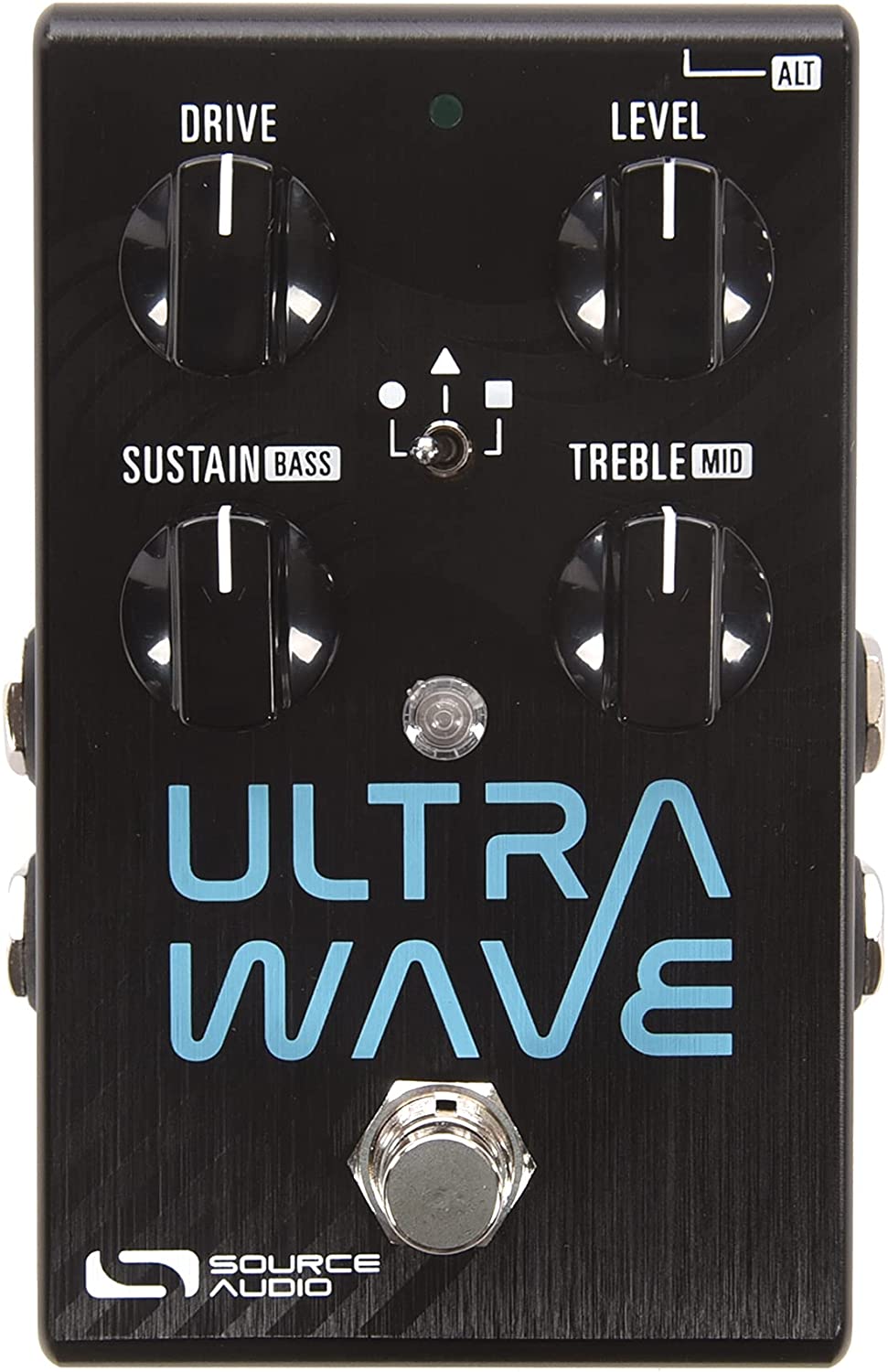
Crafted by Source Audio, the Ultrawave Multiband Guitar Processor Pedal from their One Series is more than just an effect pedal.
This black, right-hand-oriented device is designed to redefine your guitar’s tone, adding a unique touch with multiband saturation and tremolo.
A standout feature is its multiband saturation, which splits your signal into multiple bands and distorts each separately.
Furthermore, it boasts an array of distortions, making it a versatile piece of gear.
This pedal covers you whether you prefer smooth overdrive, biting fuzz, or something in between.
But that’s not all. It also includes a pro-level compressor, giving you even more control over your sound.
It is equipped with stereo 1/4″ ins and outs and is ready to integrate into any rig.
Plus, you can download companion software to tweak your sound further, making it a customizable tool.
Beyond its features, its user-friendly design is compatible with a six-string guitar featuring a tremolo bridge system.
This isn’t just a pedal. It’s a platform for musical exploration.
- My Review
So, I got my hands on the Source Audio One Series Ultrawave Multiband Guitar Processor Pedal, and it was like unlocking a new dimension of sound.
But what knocked my socks off was the synth capabilities of this pedal.
Imagine, for a moment, your guitar transforming into a full-fledged synthesizer. Wild, right?
Diving deep into the multi-effects, I discovered a sonic playground filled with a panorama of synth tones.
It was like being a kid in a candy store, but the candy was a feast of auditory delights.
Distortion, compression, tremolo, and synth effects are all wrapped up in one robust unit. You can’t beat that!
Now, let’s talk about multiband saturation.
It was like having multiple pedals in one, each band adding its color to the overall sound.
With its precise control, the built-in compressor further enhanced the synth experience, making each note pop with clarity and depth.
But the magic didn’t stop there.
The stereo 1/4″ ins and outs allowed me to integrate it into my rig seamlessly.
And the downloadable software? That was like the cherry on top, giving me the power to shape my tone like never before.
I won’t lie, though. The price tag did make me pause.
But after spending time with it, I can confidently say it’s worth every penny.
It’s not just a pedal; it’s a useful design tool, a creative partner that pushes you to explore new sonic territories.
Sure, it might not be everyone’s cup of tea.
Some may find the synth capabilities overwhelming or unnecessary.
But this pedal is a game-changer for those who dream of sculpting sounds beyond the ordinary.
Here are the ratings I’ll give to the Source Audio One Series Ultrawave Multiband Guitar Processor Pedal:
It transforms your guitar from a simple stringed instrument into a sonic powerhouse.
The Source Audio Ultrawave is more than a pedal; it’s an invitation to a world of infinite sonic possibilities.
- Pros:
- Versatile overdrive, fuzz, and harmonics.
- Ability to load other pedals into it.
- Wide range of distortion types and customizable tremolo.
- Cons:
- High price point of $250.
- Limited negative reviews available.
- Some users may find it complex to use.
My final verdict is that the Source Audio One Series Ultrawave Multiband Guitar Processor Pedal is a powerhouse of a pedal that offers a vast array of features, including multiband saturation, distortion, compression, and an impressive synth capability.
This pedal invites players to dive into a world of boundless sonic possibilities.
Despite its hefty price tag, it’s an investment in creativity and sound exploration that could be worth every penny for those willing to take the plunge.
MOOER GE300 Multi Effects Guitar Synth Pedal
MOOER GE300: Amp Modelling, Synthesizer, Multi Effects and Looper for limitless creativity.
GE300 from MOOER is a multi-effect processor featuring 108 Preamp models, 164 multi-effects, 3-voice synths, and a 30-minute looper. It allows you to sample and capture your real-life amplifier, transform your guitar into an electronic synth, and share presets with the MOOER Studio. It also offers dual footswitch stompbox, stereo looper and drum machine, and 3 individual output level controls.
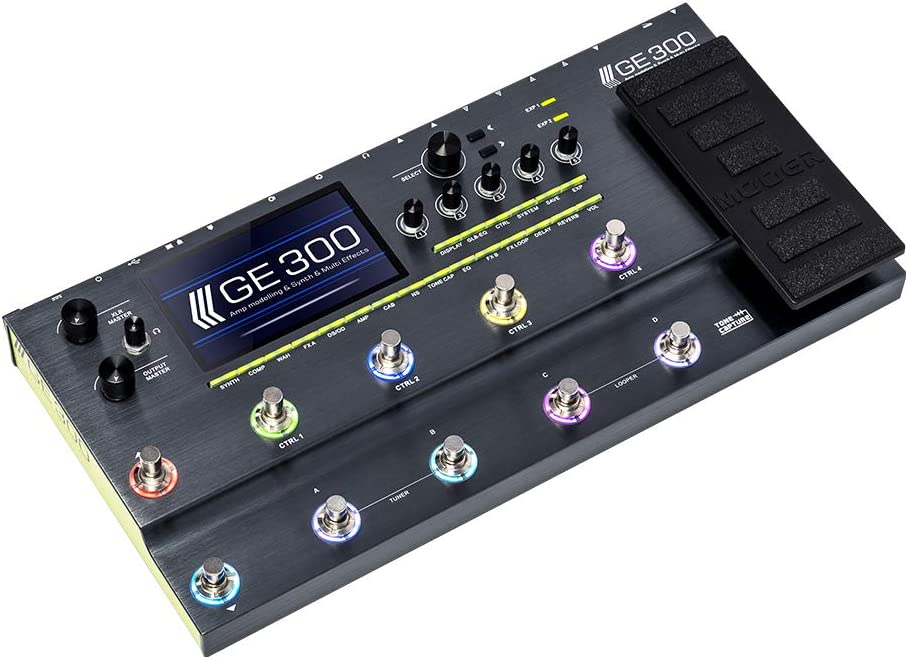
Meet the MOOER GE300 – a highly advanced, cutting-edge guitar pedal that skillfully combines amp modeling, multi-effects functions, and a guitar synth.
Its dual-DSP processors bring out the delicate attributes of each delay, reverb, or amp model within.
The user-friendly interface, diverse controls, and connectivity ports, help make this gadget a comprehensive work hub for musicians, whether they’re jamming at home, playing live, or recording in the studio.
This guitar pedal features 43 factory speaker cab models, 164 high-quality effects, and 255 preset banks, enabling you to store your favorite tone settings.
The GE300 offers 108 digital amp models that use sophisticated non-linear amp modeling technology, delivering the genuine feel and tone of tube amps.
By incorporating a Tri-voice polyphonic synthesizer module, the GE300 takes your guitar to another level, transforming it into an electronic synthesizer without needing special pickups or modifications.
Furthermore, its 30-minute capacity loop station and programmable FX loop with optional signal chain routing underscores the device’s unmatched versatility, making the GE300 the perfect companion for every guitarist.
- My Review
Singing praises for the MOOER GE300 might feel a bit understated, as I found this all-encompassing musical wonder box extraordinary.
The quality was unambiguous from the moment I unboxed it, and the functionality was a dream.
Outfitted with dual-DSP processors, its many effects and amp models clinched the deal for me.
You get top-notch sound across the board, from delays to reverb and modulation.
What stood out especially was the amp modeling technology – it’s like having a hundred-plus tube amplifier at my fingertips.
The ingenuity didn’t stop there.
The Tri-voice polyphonic synthesizer transformed my guitar into an electronic synthesizer without needing modifications—an absolute delight for anyone who loves tweaks and experimenting with sounds.
One of the standout features was the TONE CAPTURE.
Being able to sample and capture my real-life amplifier to create digital amp models was a rewarding experience.
And the instinctual controls made it refreshingly easy to operate for a device as layered as this.
The interface was surprisingly straightforward for a device with so many perks, making it a joy to use, whether in a studio or live setting.
It was sensitive to my needs, effectively providing high-quality outputs.
This doesn’t overlook some room for development.
Here are the ratings I’ll give to the MOOER GE300 Multi Effects Guitar Synth Pedal:
Specifically, the pitching shifter needs improvement, and software updates were less frequent than I had hoped.
Nonetheless, the GE300 brought something fresh to my musical experience, and with its competitive pricing, it’s a recommendable investment for ardent musicians.
- Pros:
- Top-notch dual-DSP processor.
- Over 100 amp simulations and effects.
- Streamlined user interface.
- Cons:
- Limited updates for software.
- Pitch shifter of poor quality.
- Defective USB-connectivity issue.
My final verdict is that the MOOER GE300 is an exceptional piece of equipment.
With a host of features, top-tier effects, and a user-friendly interface, it is a worthwhile investment for any musician.
Its comprehensive versatility and tone heavily outweigh its minor drawbacks.
The MOOER GE300 is a shining example of innovation and performance and is thus a highly recommendable choice.
Source Audio C4 Synth Pedal
Powerful modular synth effects for guitar or bass.
Black Market Modular System provides an all-in-one modular synthesis solution for guitarists and bassists, with distortion, delay, reverb, and more. It includes a modern control panel and expression pedal for on-the-fly sound manipulation.
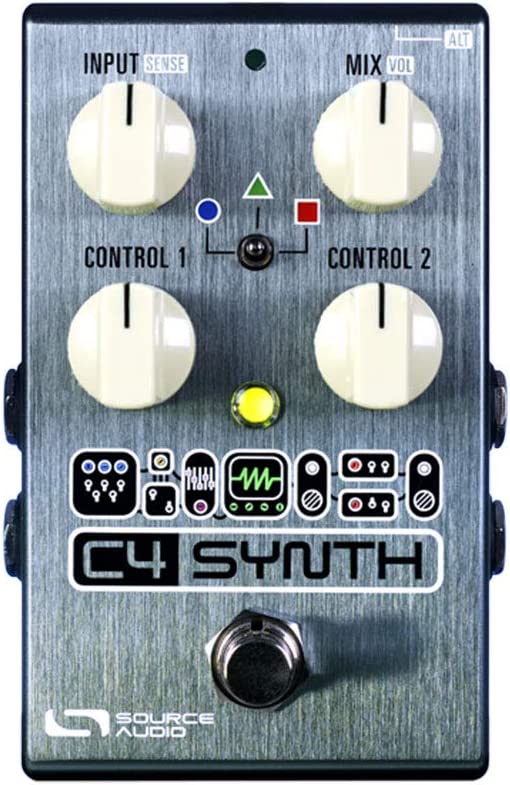
This is an exciting piece of gear designed specifically for guitar and bass players who hunger for some experimentation and quality synth sounds.
It offers musicians a versatile range of choices as a modular synth pedal.
Its powerful synth capabilities may require patience and practice, especially if you’re new to synths, but once you’re comfortable, the possibilities are endless.
What sets this pedal apart is its access to a free desktop editor app.
You might find this is almost necessary as the pedal reveals its true potential through this app, showering you with various routing options and effects.
Whether you want to tweak the presets for quick enjoyment or dive deep into synth sounds, the Source Audio C4 Synth Pedal caters to all.
All in all, it’s a bonanza for tweak-loving musicians.
- My Review
Analyzing the Source Audio C4 Synth Pedal, it was evident that it’s more than just a regular audio gear.
It delivers a multitude of synth sounds. I roused my curiosity, that’s for sure.
My time spent with this pedal blended fascination and occasional frustration.
Yet, it was all part of the journey of discovery.
First off, I was captivated by its wide-ranging versatility.
The pedal provided everything from clean, crisp tones to complex soundscapes.
There’s essentially no limit to the various sounds you can create.
Its modular capabilities are quite impressive, and it’s clear that a lot of thought has gone into the user experience.
I spun the free desktop editor and found it expanded the pedal’s potential magnificently.
A word of caution, though: it can be overwhelming for novices.
That being said, the learning curve is part and parcel of owning this pedal.
Discovering new sounds and patterns is exciting, even if it may feel daunting initially.
When it comes to the design, cleverly compact, it belies the power within.
Surprisingly lightweight, it may feel slightly flimsy to some due to its weight, but I didn’t face any durability issues.
However, the pedal isn’t without its flaws.
Some synthesized sounds, particularly at lower frequencies, felt unrefined and had underlying noise issues.
I also found the tracking to be inconsistent at times.
For musicians seeking endless sonic possibilities and willing to spend some time mastering it, the Source Audio C4 Synth Pedal is an intriguing piece of equipment.
Here are the ratings I’ll give to the Source Audio C4 Synth Pedal:
But if you want a straightforward, plug-and-play pedal, you might find it a little complex.
Nonetheless, it’s an innovative product pushing what’s possible with a guitar or bass pedal.
- Pros:
- Wide array of synth sounds.
- Free desktop editor enhances functionality.
- Compact and lightweight design.
- Cons:
- Noise issues need addressing.
- Tracking inconsistency.
- Steep learning curve for beginners.
My final verdict is that the Source Audio C4 Synth Pedal is a highly versatile and innovative gear.
Despite minor flaws like noise issues and tracking inconsistencies, its many features and tones make it a valuable addition for any musician willing to dive into synth sounds.
Overall, it offers good value for its price and is a testament to the quality we’ve come to expect from the Source Audio brand.
Boss SY-200 Guitar Synthesizer Pedal
Create compelling synth sounds with BOSS SY-200 Guitar Synthesizer Pedal.
The BOSS SY-200 offers a wide range of analog-flavored polyphonic tones for guitar and bass in a small footprint. It provides 171 sounds with adjustable parameters, 128 memory locations, and real-time control plus external footswitch and expression pedal options. Latency-free performance makes it a seamless extension of any instrument.
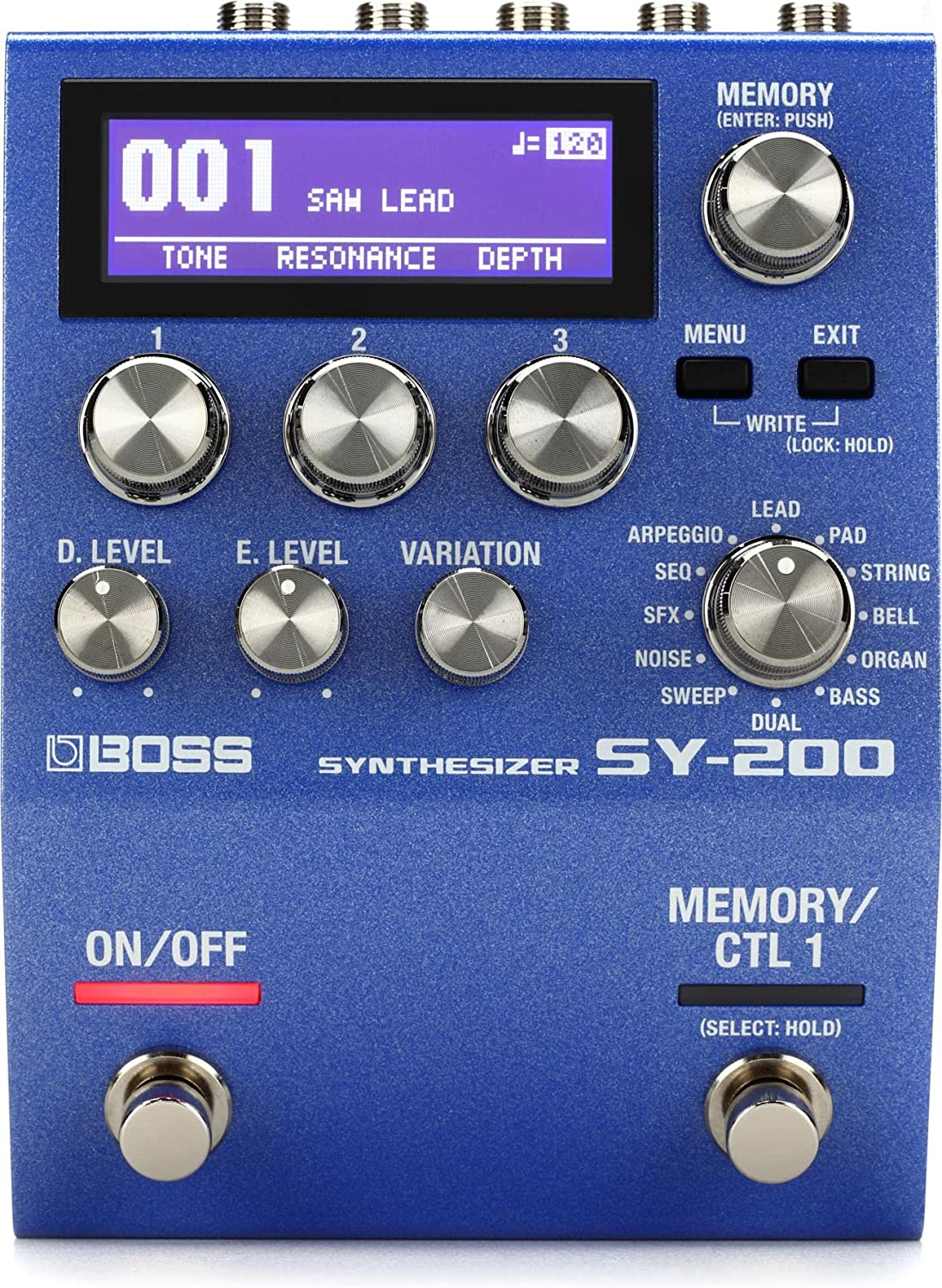
Let’s dive into the multifaceted Boss SY-200 Guitar Synthesizer Pedal.
Designed for both guitar and bass, this reliable, compact silver and blue pedal gives you access to an impressive 171 polyphonic synth sounds, promising a host of tuneful adventures.
Its power lies in its simple operation and broad sonic range, with an extensive library of expressive synth tones categorized into 12 simple sections.
The SY-200 is easily adjusted for perfect balance, thanks to its clear display and hands-on controls.
Its dimension is pretty compact, measuring 7.85 X 6.75 X 4.35 inches and weighing only 1 pound, and yet, it’s underpinned by advanced technology.
The pedal shines with 128-user presets, comfortably storing your favorite sounds for instant recall.
With deep real-time performance control via two footswitches, you can add depth to your performance by hooking up external footswitches, an expression pedal, or MIDI for more expansive control.
- My Review
Donning my rocker’s hat, I spent quality time with the Boss SY-200 Guitar Synthesizer Pedal.
It’s a remarkable piece of tech, making it incredibly easy to explore and utilize Boss’s guitar and bass synth technology.
It has a compact build yet is loaded with rich polyphonic tones.
It’s like having a universe of intricate, analog-esque tones under my foot.
Diving into it, the pedal came to life.
It offered a choice of 171 sounds. Quite a palette, I must say!
The classification into 12 intuitive categories made navigation a breeze.
I could tweak the tones and response through adjustable parameters.
The great bit is that I could save my favorite sounds in one of the 128 memory presets.
The SY leads to an exciting soundscape from the Roland engine and handy user preset facility.
To help layer the intricate tones, you can delve into footswitches or enigma the pedal with an expression pedal or MIDI.
However, I do have a bone to pick.
A device of this caliber without a power supply is quite a letdown.
THE LACK OF A POWER ADAPTER DISHEARTENS ME when I factor in the high price tag.
Balancing out the downer, the SY-200 impressed me with its seamless integration into various setups.
Its send and return loop and level knobs allow for crafting unique hybrid sounds.
Interacting with the SY-200 was straightforward and efficient.
The responsive display and hands-on controls expeditiously delivered sounds and balanced direct and synth levels.
The pedal’s note tracking is top-tier – fast, accurate, and detailed.
Here are the ratings I’ll give to the Boss SY-200 Guitar Synthesizer Pedal:
The myriad of sounds, from bass, synth brass, and strings to the explosive one-shot sounds, this pedal certainly left an indelible mark on my musical journey.
However, remember, it’s quite an investment in time and money!
- Pros:
- Wide range of polyphonic synth sounds.
- 128 user presets for custom sounds.
- Enhanced real-time performance control.
- Cons:
- High price point.
- Lacks included power supply.
- Subtle latency with certain sounds.
My final verdict is that the Boss SY-200 Guitar Synthesizer Pedal is a versatile and high-performing technology for musicians seeking a wide range of synth tones, fast tracking, and real-time performance control.
Despite its steep price tag and lack of a power supply, it offers a vast sound library, robust presets, and seamless integration.
Its enriching sonic capabilities and easy navigation make it a worthy addition to any pedalboard.
Therefore, this pedal could be a valuable and inspirational tool if you’re an artist eager to experiment and evolve musically.
EarthQuaker Devices Bit Commander Guitar SynthPedal
Vintage square wave synth tones in an easy-to-use analog pedal.
The bit Commander is an analog guitar synthesizer with four octaves of square wave tones, allowing for a wide variety of sounds without having to dial in envelopes or oscillators. It is designed for single note usage, with best tracking from the 7th fret up on all strings, and yields unexpected results on lower registers.
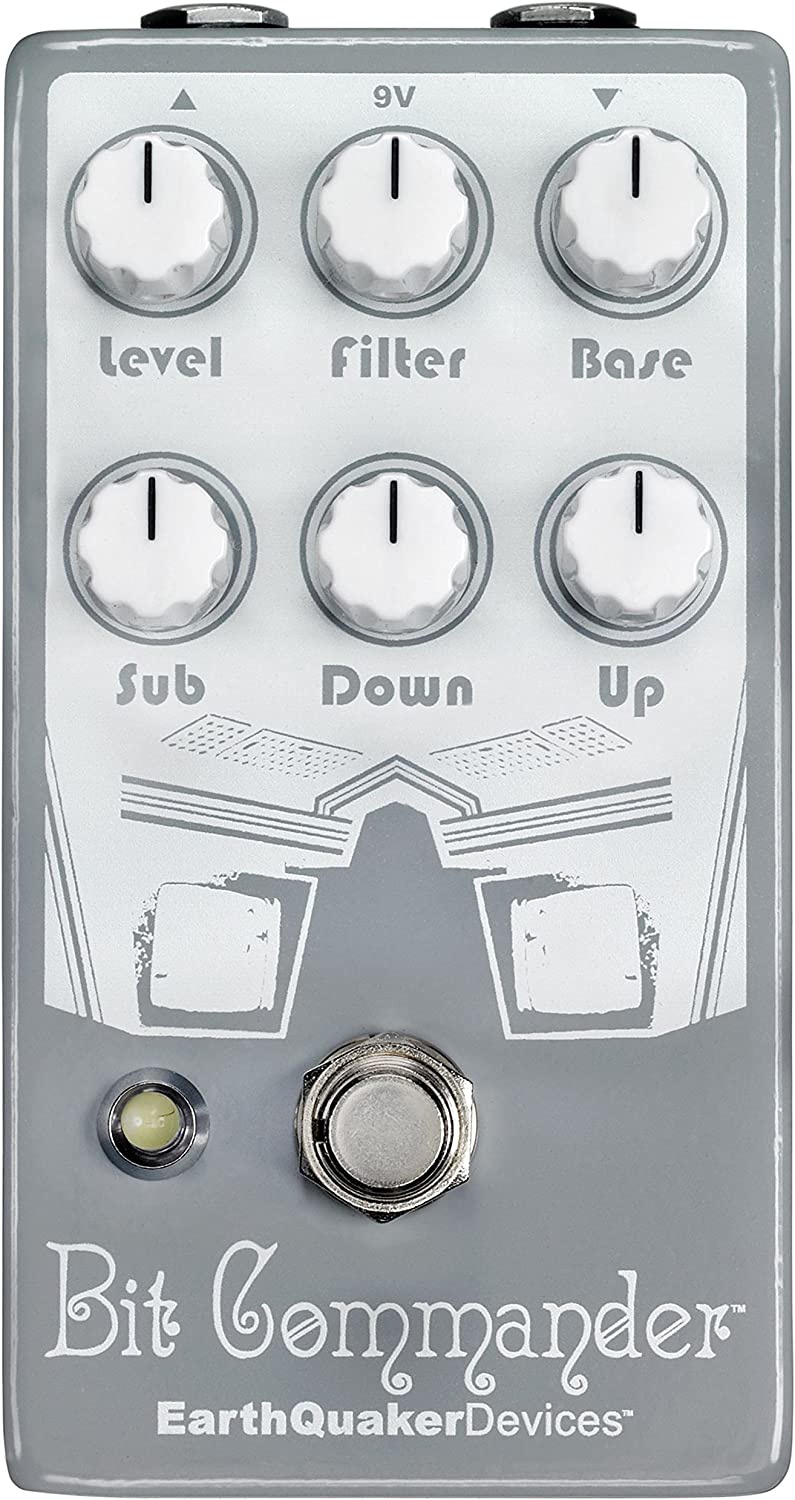
Handcrafted in the heart of Akron, Ohio, the Bit Commander from EarthQuaker Devices is a must-have for guitarists craving vintage, synth-like tones.
This analog, monophonic guitar synthesizer pedal features a user-friendly interface that lets you easily manipulate octaves, creating a sound spectrum without requiring complex adjustments to envelopes or oscillators.
Its compact size, measuring about 5.7 x 3.35 x 3.25 inches and weighing only 0.4 kilograms, makes it a lightweight addition to your pedalboard.
Operating at 9 volts, the Bit Commander generates four distinct octaves – a sub-octave thump, an octave down pulse, a slightly squared base tone, and a swelling octave up.
When blended, these tones produce the effect of a legion of vintage synths, all from a single guitar.
For best results, stick to single notes on the neck pickup and play from the 7th fret.
You might notice occasional glitches with lower notes – but don’t worry; that’s part of the unique charm of analog octave effects!
- My Review
Well, let’s talk about this interesting piece of kit, the Bit Commander V2 by EarthQuaker Devices.
Right out of the gate, I noticed its compact, lightweight design that easily finds a home on any pedalboard.
Crafted with an intuitive, no-fuss interface, it allows even a novice like me to play around with the vintage square wave synth tones and get a feel for their unique characteristics.
No need for complicated envelope adjustments or oscillator tweaking; it’s as simple as dialing in the desired octaves to hit a vast array of sounds.
But it’s not just about variety; the richness of the tones truly stands out.
The pulsating octave down, the sub-octave thump, the lightly squared base tone, and the swelling octave up combine to produce a sound that’s not just pleasing to the ear but also downright addictive.
You’d swear it’s a whole band of old-school synths, not a single guitar.
Every rose has its thorn, and the Bit Commander is no exception. It does require some finessing.
For instance, it prefers the neck pickup and performs best from the 7th fret.
Also, the lower you go, the more it struggles with tracking, leading to occasional glitches and stutters.
However, these oddities add to their charm in a strange twist, providing an unexpected texture to the sound.
You might think of it as a bit of a one-trick pony, but what a trick it is!
This pedal can deliver a glitchy, broken-octave fuzz sound or fancy trippy-sounding arpeggios.
I see it more as a tool for sound exploration than a standard staple.
Here are the ratings I’ll give to the EarthQuaker Devices Bit Commander Guitar SynthPedal:
And honestly, that’s part of its allure.
The Bit Commander doesn’t just mimic vintage synth tones; it invites you to rethink your music-making approach.
- Pros:
- Compact and lightweight design.
- User-friendly interface.
- Rich, versatile vintage synth tones.
- Cons:
- Occasional glitches with lower notes.
- Optimal performance limited to higher registers.
- May be seen as a one-trick pony.
My final verdict is that the EarthQuaker Devices Bit Commander V2 Monophonic Analog Guitar Synthesizer Pedal is a solid purchase for those seeking an easy-to-use pedal that delivers a wide range of vintage synth tones.
Its unique sound and user-friendly design stand out, making it a valuable addition to any pedalboard.
Despite occasional tracking glitches with lower notes and some limitations on versatility, its overall performance and the richness of the tones it produces are compelling.
For those who value the richness and variety of vintage synth tones and are willing to navigate its quirks, this pedal could be the missing piece in their sonic puzzle.
Aural Dream Gamba Tone Synthesizer Guitar Effect Pedal
Authentic Gamba tones with True Bypass and vibrato module.
This Stompbox pedal features 5 parameters knobs and 5 sound types, providing a range of guitar effects. It comes with a Gamba score and requires DC 9V power supply. Its compact size and lightweight design make it easy to transport and install.
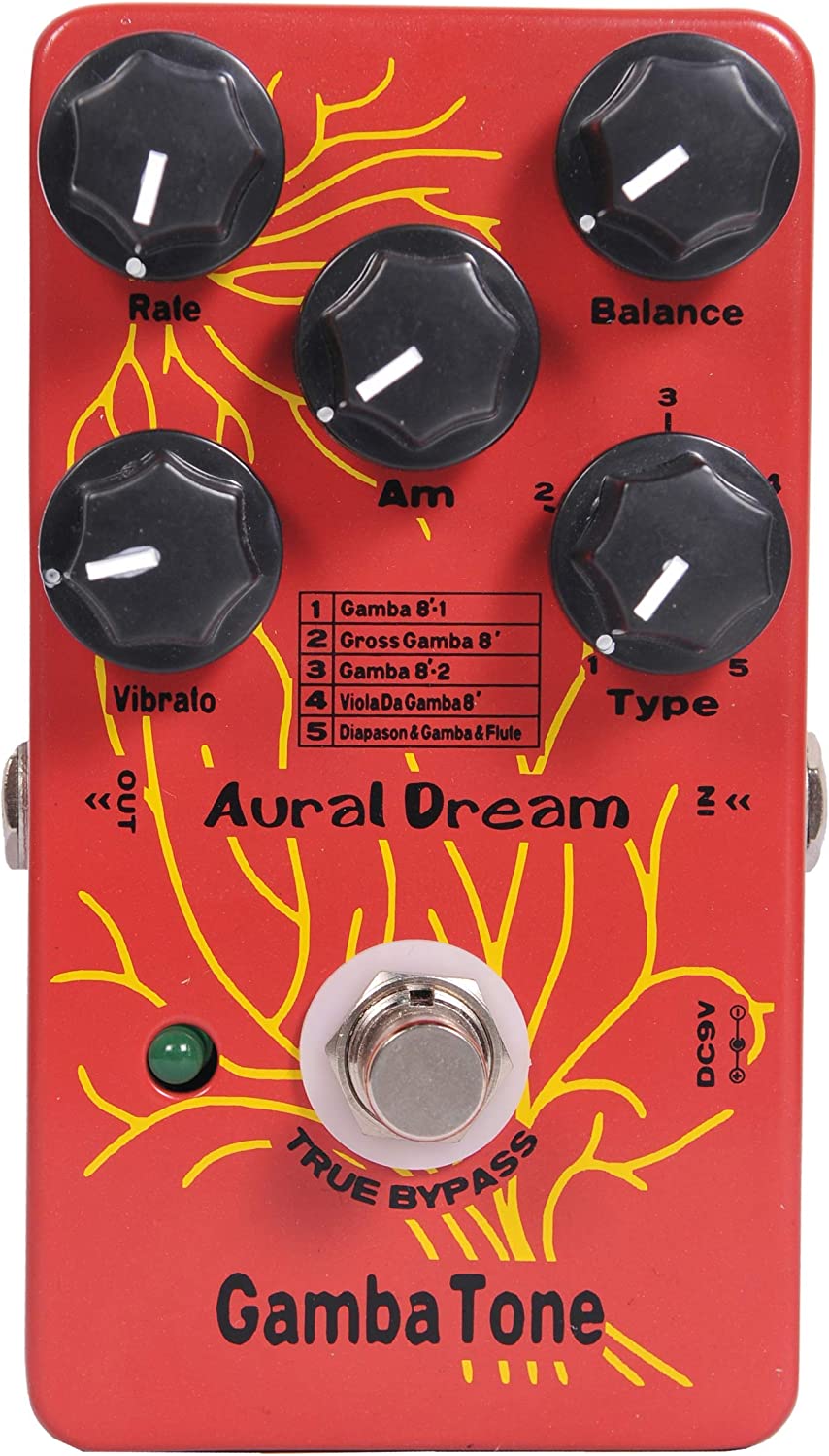
The Aural Dream Gamba Tone Synthesizer has innovative features to elevate your sound.
It boasts five distinct Gamba effects and a wide range of tonal possibilities.
This pedal’s true bypass design, along with its low noise and power-efficient circuits, ensures the purity of your signal.
What sets this device apart is its adjustable vibrato module, which allows you to modify the depth and rate of the effect effortlessly.
Another highlight is the amplitude modulation module, providing an additional layer of sound manipulation.
On top of this, the rotary module can be freely controlled for precise rotation speed adjustments, enabling easy airflow customization.
Its compact size – measuring just under 5 x 2.7 x 2 inches – is also worth noting.
But don’t let its small footprint fool you; it’s built to last with its sturdy aluminum alloy casing.
It runs on a DC 9-volt power supply for best results, consuming a minimal 50 milliamps.
The Aural Dream Gamba Tone Synthesizer is a compact powerhouse of a pedal.
- My Review
Let’s dive into the heart of the Aural Dream Gamba Tone Synthesizer Guitar Effect Pedal.
First off, this pedal’s form factor is just right.
Not too big, not too small, fitting snugly on my pedalboard with its dimensions of roughly 5 x 2.7 x 2 inches.
The solid aluminum alloy casing reassured me about its durability from the start.
When I plugged in and powered it up with a DC 9-volt supply, I was immediately taken aback by the range of Gamba effects.
Five unique soundscapes, each one more impressive than the last.
It was fascinating to discover how each module could be manipulated, from the vibrato’s adjustable depth and rate to the rotary’s speed control.
Talk about a sound smith’s dream come true!
What struck me, even more, was its true bypass feature. It’s as if the Aural Dream folks have thought of everything.
My signal remained pure and uninterrupted, and the noise level was impressively low.
The pedal is power-efficient, too, consuming only about 50 milliamps. Now that’s what I call mindful design.
Yet, the pedal’s not without its quirks.
One of them is the placement and labeling of the parameter knobs.
Initially, it took me some time to get used to them, and an improved design could make this product even more user-friendly.
However, once I spent time with it, I started appreciating the precise control these knobs provided.
Here are the ratings I’ll give to the Aural Dream Gamba Tone Synthesizer Guitar Effect Pedal:
Navigating the Gamba effects – Gamba 8′-1, Gross Gamba 8′, Gamba 8′-2, Viola Da Gamba 8′, or Diapason and Gamba and Flute – was like a thrilling sonic journey.
My takeaway? The Aural Dream Gamba Tone Synthesizer is a substantial piece of gear that lives up to its promise of providing a distinct musical experience.
- Pros:
- Versatile with 5 different Gamba effects.
- True Bypass for cleaner signal when bypassed.
- Low noise and low-power circuits.
- Freely controlling Rotary module.
- Cons:
- Requires DC 9V power supply.
- May not be suitable for all music styles.
- Limited information on specific modulation options.
My final verdict is that the Aural Dream Gamba Tone Synthesizer Guitar Effect Pedal is a versatile and feature-rich option with great tone and performance.
A reputable brand backs it and offers good value for its features.
However, it is important to note that its suitability may depend on personal preferences and music styles.
It is a solid choice for guitarists seeking a unique and customizable sound.
Empress Effects ZOIA Modular Synthesizer Pedal
Create custom effects, synths, and much more.
ZOIA is a modular synthesizer in pedal form which enables users to create custom effects, synthesizers, midi controllers and virtual pedal boards. It includes pre-made modules for guitar effects, allowing users to easily create their own sound.
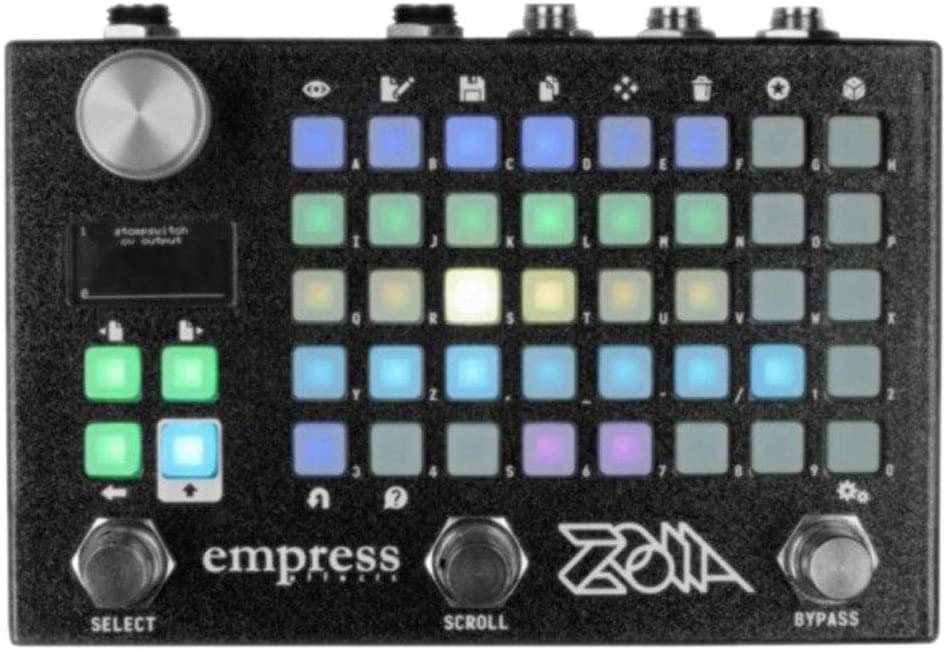
Let me share some information about a unique product – the Empress Effects ZOIA Modular Synthesizer Pedal.
This isn’t your average pedal.
Picture a modular synthesizer shrunken into pedal form.
With ZOIA, you’re not simply adding a delay or tremolo effect.
It gives you the building blocks to construct these effects from scratch – and tailor them as you wish.
ZOIA is filled with over 80 modules, providing various oscillators, LFOs, filters, bit crushers, envelope followers, and more.
You’re only bound by your creativity!
You’ll find pre-configured effects like reverbs, delays, flangers, and overdrives in selecting more than 20 ready-to-go effects modules.
Additionally, it allows you to craft and save up to 64 custom patches.
This is all encased in a sturdy silver and black unit designed to handle a musician’s life.
- My Review
Having spent considerable time with the Empress Effects ZOIA Modular Synthesizer Pedal, I can confidently say it’s a remarkable piece of equipment.
Still, it requires a fair bit of patience to unlock its potential.
The ZOIA is a treasure trove of opportunities for those hungry for sound exploration.
Loaded with over 80 modules, this little silver and black box offers a platform to sculpt the very essence of your sound, from oscillators and LFOs to filters and bit crushers.
Now, it’s important to note that ZOIA is not just a simple pedal – it’s akin to a fully-fledged programming platform.
The chance to build your effects and synth sounds is genuinely exciting.
That said, it’s not a walk in the park.
If you’re expecting a simple plug-and-play experience, ZOIA might be a bit daunting.
However, the investment in time to learn the basics, while substantial, is incredibly rewarding.
Let’s touch on the physical aspects – the build quality is robust and designed to be stepped on literally.
Yet, the compact screen could be a drawback for some.
Despite being functional, its small size makes reading challenging, especially in bright light conditions.
ZOIA boasts more than 20 ready-made effects modules and allows for creating and saving up to 64 custom patches.
But, I must point out a notable omission – the absence of USB MIDI functionality.
It’s a feature I would’ve loved to see for a pedal of this nature and price point.
The ZOIA presents a fascinating proposition for any musician.
Here are the ratings I’ll give to the Empress Effects ZOIA Modular Synthesizer Pedal:
It’s a formidable tool filled with creative possibilities, but the learning curve is steep.
For those ready to take on that challenge, the rewards are plentiful.
- Pros:
- Unique and creative pedal.
- Limitless possibilities and customization.
- Can replace multiple pedals.
- Well-made and durable.
- Great community support and user patches.
- Cons:
- Small and hard-to-read screen.
- Potential issues with LED durability.
- Poor customer support experience for some.
- Relies heavily on front panel LEDs.
- Rubber feet may come off easily.
My final verdict is that the Empress Effects ZOIA Modular Synthesizer and Guitar Multi-Effects Pedal is a highly versatile and feature-rich product with limitless possibilities for creating custom effects and synths.
It has received positive reviews regarding its innovative capabilities, sound quality, and active user community.
However, it has some drawbacks, such as a small screen, potential issues with LED durability, and reported customer support concerns.
Despite these drawbacks, the ZOIA remains a powerful tool for musicians seeking customization and creative exploration.
Keeley Synth-1 Fuzz Wave Generator Pedal
Create fuzzy synth sounds with Keeley Synth-1 Reverse Attack Fuzz Wave Generator Pedal.
The Keeley Synth-1 produces fuzzy synth-like tones, blending your guitar sound with adjustable Filter, Attack, and Blend controls. Use an expression pedal to control the Filter for Wah-Wah-like control of the sound.
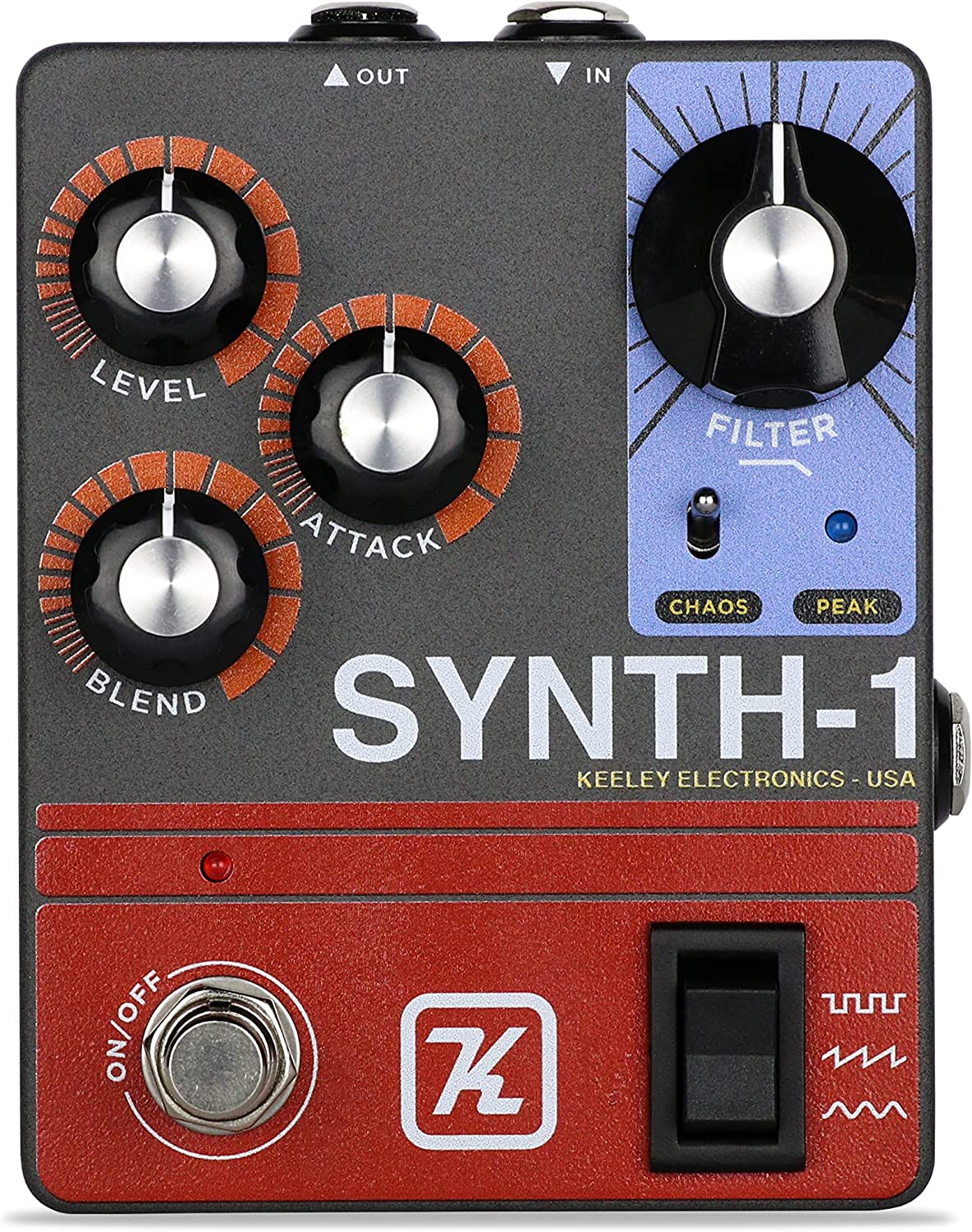
Delve into a world of synthesized sonic exploration with the Keeley Synth-1 pedal.
This unique device allows guitarists to produce singular synth tones steeped in fuzzy textures.
Innovative controls let you dial in your sound exactly as desired; you can mix your guitar’s natural tone with synth fuzz using the Blend and Filter knobs.
Moreover, it can take you on a journey from creating gentle, slow-gear reverse swells to emulating the fierce clash of a lightsaber.
A standout feature of this gray Synth-1 pedal is its guitar-triggered, mono-note wave generation ability.
This lets you manipulate the wave’s tone using the Filter control.
You can also dictate the lead-in time, or the note’s swell, through the Attack knob.
For more dynamic control, consider coupling an expression pedal to tweak the Filter on the fly, thereby obtaining a Wah-Wah-like effect.
This device functions at 9 volts and comes compact with dimensions of 3 x 3 x 3 inches, making it a perfect fit for your pedalboard.
- My Review
From the moment I first plugged into the Keeley Synth-1 Reverse Attack Fuzz Wave Generator Pedal, I knew I was embarking on an unprecedented sonic journey.
This isn’t your standard pedal.
Its striking gray color and practical 3x3x3 inch dimensions make it a snug fit on any pedalboard, yet its capabilities are colossal.
Let’s talk about its core offering – the fuzzed-out synth sounds.
Dialing in unique, textured tones is as smooth as butter.
The Blend control is a revelation, allowing me to mix my guitar’s organic sound with Synth-1’s fuzzy offerings, from deep, ominous tones to brighter, almost sci-fi-like sounds.
Think slow-gear reverse swells to light-saber clashes – it’s an array of expressions that’s literally at your feet.
With the Filter knob at my disposal, I easily shaped the EQ and tone of the fuzz waves.
This pedal is like a sonic playground, and the Filter function is one of the main attractions.
I couldn’t help but experiment, finding new blends of guitar and synth that transformed my soundscapes.
Adding to the fun, there’s the Chaos Switch, a nifty tool that pushes the pedal’s capabilities to new realms.
It changes dimensional triggering, octaves, and, honestly, everything in between.
It’s more than just a footswitch; it’s a ticket to uncharted sonic territories.
Now, if you like precise control, the Synth-1 shines even brighter.
The Attack knob allows you to manage the lead-in time or swell of the note.
And are you using an expression pedal with the Filter control?
It’s like having a Wah-Wah on steroids.
Running at 9 volts, this pedal is not just powerful; it’s efficient too.
Yet, despite its out-of-the-box thinking and wide-ranging capabilities, it’s not for everyone.
Here are the ratings I’ll give to the Keeley Synth-1 Fuzz Wave Generator Pedal:
If you’re searching for classic, down-to-earth sounds, it might seem a bit over the top.
But for unconventional explorers, the Synth-1 is a must-try – the wild card can turn your performances into standout spectacles.
- Pros:
- Creates unique synth-like guitar sounds.
- Allows for volume swell effects.
- Offers versatile waveform selection.
- Cons:
- Potential learning curve for optimal usage.
- May not be suitable for those seeking traditional guitar tones.
- Requires an expression pedal for full control.
My final verdict is that the Keeley Synth-1 Reverse Attack Fuzz Wave Generator Pedal is a highly versatile and feature-rich pedal that offers unique synth-like guitar sounds and volume swell effects.
It excels in performance and provides a wide range of waveform options.
The brand, Keeley, is known for its quality products.
While it may not suit those seeking traditional guitar tones and requires an expression pedal for full control, its overall value is commendable.
If you want to explore innovative and experimental sounds, the Keeley Synth-1 could be a valuable addition to your pedalboard.
Pigtronix Mothership 2 Analog Synthesizer Pedal
Velocity-sensitive pitch-tracking analog synthesizer with hard sync and glide modulation.
The Printronix Mother Ship 2 is a velocity-sensitive, pitch-tracking, three-voice analog synthesizer with oscillator hard sync and pitch modulation. It features five, custom-made dual-concentric potentiometers and a pair of toggle switches, offering a user-friendly guitar synth with real-time pitch and amplitude tracking, switchable preset tunings and a sync effect for creating unique sounds.
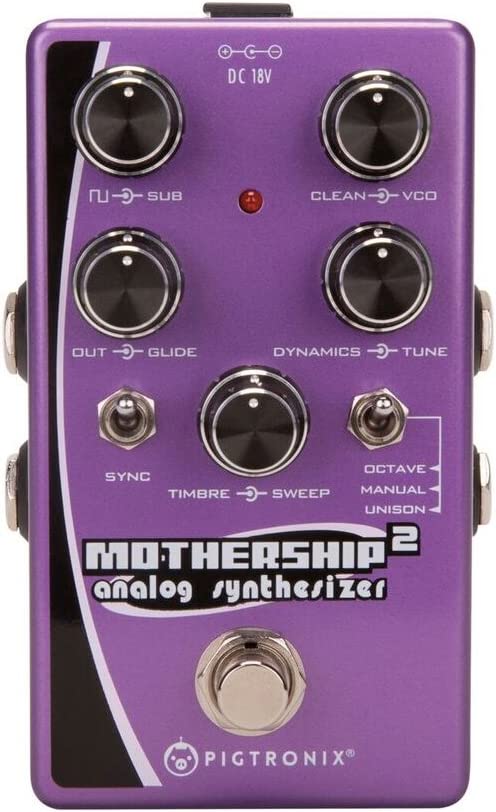
Experience the groundbreaking technology of the Other Guitar Signal Path Effect in striking purple (MS2).
This compact, velocity-responsive, pitch-tracking, triple-voice analog synthesizer brings track-altering oscillator hard sync and pitch modulation to the table.
Aptly housed in a petite aluminum chassis, the MS2 boasts an easy-to-use guitar synth, offering real-time pitch, amplitude tracking, toggle-able preset tunings, and a jaw-dropping sync effect.
This pedal opens up a new world of modulation effects for guitarists, bassists, and audio explorers.
Handy features such as individual level knobs for VCO and square wave voices, a powerful sub-octave sine wave voice, adjustable dynamics function, and a a preset-switch elevate the user experience.
Its unique sync function sets the MS2 apart, resulting in a pitch-locked, unison sound backed by intense harmonics and overtones.
Moderated by the sweep controls, Glide function, and timbre controls, the sync effect presents many original sounds.
This gear symbolizes Printronix’s commitment to the audio industry’s future.
- My Review
Diving headfirst into the Purple Other Guitar Signal Path Effect, most notably known as the MS2, I must admit it feels like an intergalactic voyage.
Nestled comfortably in its compact aluminum body, this pitch-tracking, three-voice analog synthesizer pulls no punches, drawing you into its unique orbit.
At first glance, the panel looks a little complicated, but it doesn’t take too long to decipher.
Five custom-made dual-concentric potentiometers and a pair of toggle switches set the control stage.
Dialing in the gain on the triangle wave and square wave voices brought an exciting new texture to my jam session.
Additionally, the clean guitar sound managed to maintain its crispness while the sub-octave sine wave added a punchy undertone.
Navigating this beast, however, takes a moment of quiet contemplation and patience.
It’s certainly not an instant-gratification device.
It’s almost like taming a wild bronco – unpredictable but rewarding.
Adjusting the dynamics and fine-tuning for a personalized touch felt empowering.
The MS2’s preset tuning switch even offers options for unison, octave up, and interval presets, which offer a delightful range of possibilities.
My experiments with the sync function impressed me.
The ability to create pitch-locked, unison sounds with complex harmonics feels like unlocking a hidden Pandora’s box of tones.
Now, the kicker was the sync effect, which can produce a sheer array of unique sounds.
By manipulating the sweep, glide, and timbre controls, I had an arsenal of unlimited modulation and pitch effects at hand!
Here are the ratings I’ll give to the Pigtronix Mothership 2 Analog Synthesizer Pedal:
In this tête-à-tête with the MS2, I realized that this piece of equipment doesn’t just challenge your playing; it can elevate it – if you’re patient enough to delve into its many layers.
It’s a bit of an enigma wrapped in a purple shroud that beckons the authentic tone-space explorers.
- Pros:
- Amplitude tracking and pitch modulation.
- Adjustable dynamics for personalized output.
- Varied unique sound possibilities.
- Cons:
- Initially complicated control setup.
- Demanding learning curve.
- Time-consuming sound sculpting.
My final verdict is that the Other Guitar Signal Path Effect, Purple (MS2) is a captivating piece of music tech.
It offers a platform to experience and experiment with highly interactive sounds and tones.
Its complexity may be challenging for novices but serves as a rewarding journey for those willing to explore its vast potential.
This equipment isn’t just about producing sounds but about an immersive experience—a journey through melodic galaxies.
The learning curve may be steep, and the time required to master it may be significant, but once harnessed, its capacity to transform your music is profound.
It’s definitely an investment worth considering for earnest musicians seeking an infusion of innovation and uniqueness in their sound.
DOD Sub-Synth Guitar Effects Pedal
Sub-harmonic enhancement for bass, guitar, synth and drums.
The DOD Meatbox adds extra low-end power to bass, extended-range and down-tuned guitars, synths and drum machines. It features modern updates like true bypass, TRS output, 9-volt power supply input, and a bright LED.
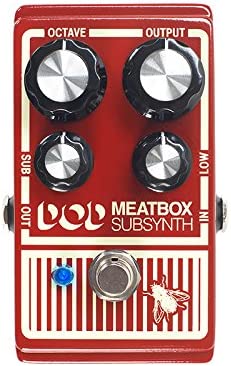
Meet the revamped iteration of the iconic DOD Meatbox pedal: the DOD Sub-Synth Pedal – Reissue.
Staying true to the original’s legendary circuit design, this DigiTech pedal provides subharmonic enhancement.
This characteristic has made it a popular choice among musicians keen on adding depth and power to their bass sounds.
Its design is updated with new features such as an LED status light in a distinctive blue, TRS Output, and reliable true bypass.
Structured in a robust yet lightweight aluminum shell, this pedal boasts compact dimensions and minimal weight.
The updated version of this cult classic is even more suited for bass guitars, extended-range and down-tuned guitars, synthesizers, and even drum machines.
This reissue combines the original’s much-loved elements with contemporary enhancements for today’s musicians.
- My Review
Bridging the gap between classic charm and modern functionality, the DOD Sub-Synth Pedal – Reissue surpassed my expectations.
I had my sights set on discerning the impact of this reimagined pedal, with its roots in the iconic 1990s DOD Meatbox circuit design.
The updated elements proved to be the game changer.
Once plugged in, the first thing that caught my was the pedal’s effective subharmonic enhancement.
It added a power-packed, low-end punch to the music — something bass fans will appreciate.
Pair it with a bass guitar or a synthesizer, and you’re treated to a substantial boost in sonic depth.
Even when I tried it with a drum machine, it excelled.
Yet there is much more to this pedal than just offering massive power.
While the reissue’s sturdiness and compact size surpassed my expectations, the operational aspects and control parameters truly resonated with me.
The output level, for instance, is notably higher than the original, offering you that extra bit when needed.
The controls are intuitively marked — a great mix of usability and tradition maintained with labels like “OCTAVE”,” “SUB”,” “LOW”,” and “OUTPUT.”
Now let’s talk about the nuances.
Splitting the signal with a standard instrument cable that goes stereo to mono is where this pedal splits away from the norm — a feature that stood out to me.
This impacts a studio recording environment and if you intend to use the Meatbox at the start of parallel effect chains.
Here are the ratings I’ll give to the DOD Sub-Synth Guitar Effects Pedal:
Additionally, the true bypass and TRS output provided an element of reliability and flexibility, and the bright blue LED served a functional purpose and added a dash of aesthetic appeal.
From a studio setting to a live rig, the DOD Sub-Synth Pedal-Reissue bridged all gaps and cemented its place as a worthy reinvention.
- Pros:
- Updated design with modern components.
- Enhanced sub harmonic enhancement for low-end power.
- Compact, sturdy, and lightweight construction.
- Cons:
- Differentiated output may require special cables.
- Potential risk to amp/cabinet with excessive use.
- Requires tweaking for optimum performance.
My final verdict is that the DOD Sub-Synth Pedal – Reissue is a proficiently designed piece of gear that successfully merges the much-loved qualities of a classic with contemporary enhancements.
Its significant, low-end power and modernized features make it a versatile and worthy investment for any musician’s toolkit.
You might need some tweaking to hit the sweet spot, but the effort is worth the outcome.
Its robust construction and the added reliability of a household brand like DigiTech seal the deal.
Despite a few cons, its value, performance, and power made it a must-own pedal.
TC-Helicon Talkbox Synth Pedal
Classic and new vocal effects with Adaptive Tone and pitch correction.
TALKBOX SYNTH provides a range of classic and new vocal sounds, from the iconic Talkbox to robotic effects. It also includes Adaptive Tone, studio-grade reverb, and pitch correction for improved vocal sound, even when the effect is off.
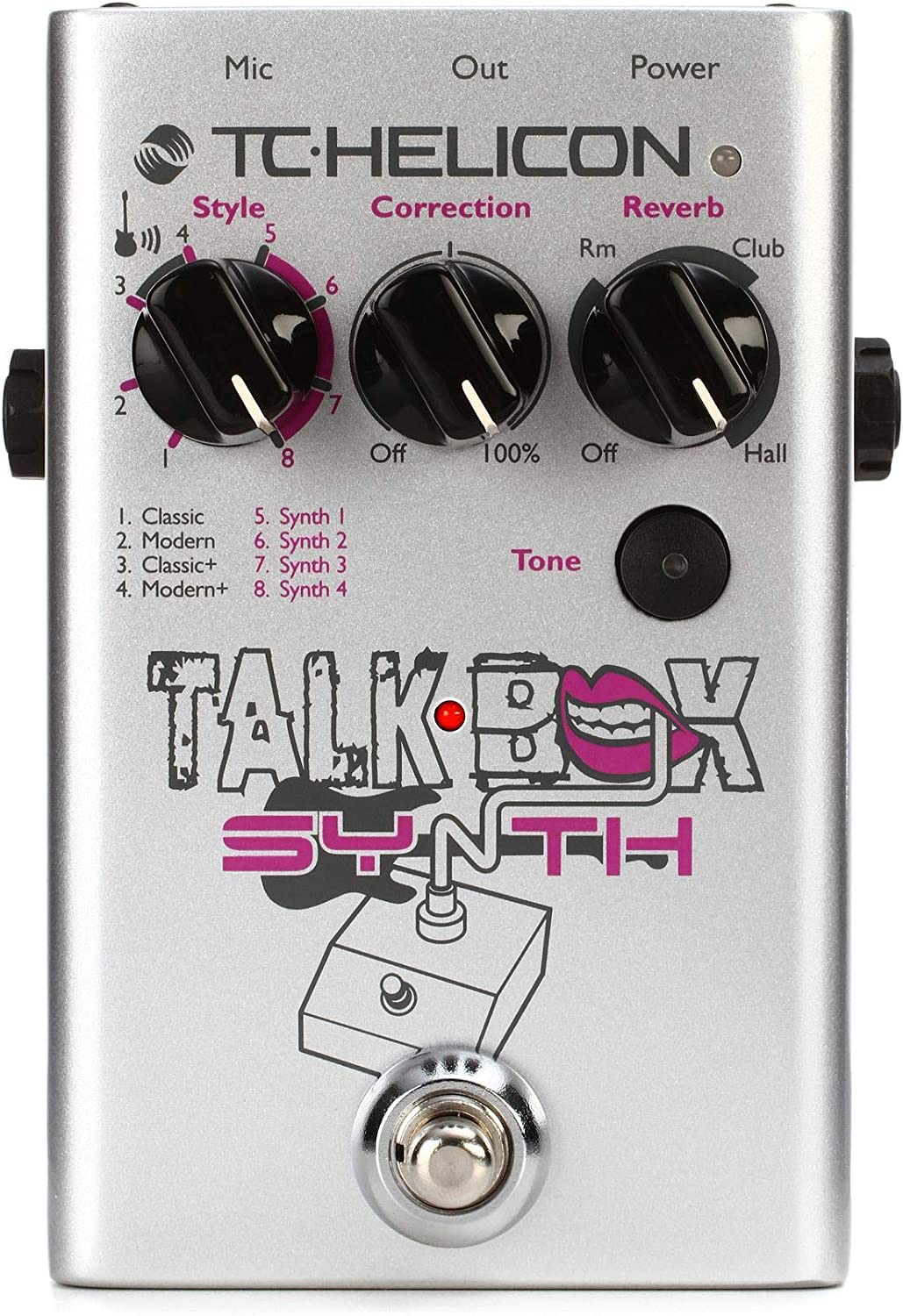
Take the stage with the TC-Helicon Talkbox Synth, a vocal effects pedal for guitarists.
As the name suggests, this device expertly recreates the classic talkbox sound effect loved by many musicians, both for nostalgia and the quirky twist it adds to the performance.
Its state-of-the-art tech also allows it to deliver unique ‘talking robot’ audio effects.
What sets this device apart is its ability to add pitch correction and studio-quality reverbs to your vocals, even when the main effect is switched off.
This vocal processing power is a massive win, essentially decking out your core vocal sound with Adaptive Tone.
It’s a versatile gadget for any guitarist, whether you’re jamming at home, performing at local gigs, or touring with your band.
Of course, that special talkbox performance spark only adds to its allure.
So, bring life to your performances with this one-of-a-kind talkbox synth gadget that has the potential to turn you into an instant crowd-pleaser.
- My Review
When you initially lay your hands on the TC-Helicon Talkbox Synth, the robustness is the primary attribute of its build quality that jumps out at you.
This pedal feels sturdy and seems like it’s made to withstand heavy use.
Generally, a hard-wearing device for those countless gigs is an advantage, and with this Talkbox Synth, reliability is certainly a strong suit.
Diving into the functionality, the Talkbox Synth offers a rich range of options.
It boasts the unique ability to mimic nostalgic talkbox sounds and comes with an intriguing ‘talking robot’ effect – each one distinct and a real crowd-pleaser.
The tonal hues you can unlock are impressive and genuinely injects boldness into performances.
Having used the device, the allure comes with the quality of tonal variations it offers each time you engage it.
One important aspect to mention is the much-lauded Adaptive Tone functionality.
This noticeably elevates the core vocal sound with pitch correction and studio-standard reverbs.
It’s a subtle yet significant addition that builds on producing an audio experience that can engage an audience.
Now let’s talk about power.
The TC-Helicon Talkbox Synth requires a specific type of power supply.
It’s a minor inconvenience, given the product’s impressive capabilities, but something to keep in mind when setting up your rig.
On a critical note, the footswitch had some issues.
There might be a learning curve in getting it to switch effectively.
Still, once you overcome this hurdle, the effects of the offer are well worth the effort.
The sound replication is eerily similar to a traditional tube-driven talkbox, eliminating the need to clean and handle the tube, which can be a real game-changer.
The TC-Helicon Talkbox Synth is a mixed bag — offering exciting possibilities and good options yet requiring patience to uncover its potential truly.
Here are the ratings I’ll give to the TC-Helicon Talkbox Synth Pedal:
It’s a versatile gadget that certainly enriches your audio artillery.
Despite some quirks, it delivers a vibe that’s hard to ignore, making you stand out on stage.
- Pros:
- Durable and robust build quality.
- Offers a wide range of sound effects.
- Superior core vocal sound improvement.
- Cons:
- Requires specific power supply.
- Footswitch could be problematic.
- Learning curve to fully utilize.
My final verdict is that the TC-Helicon Talkbox Synth is a solid, versatile addition to any musician’s toolkit.
Despite minor quirks with the footswitch and power supply requirements, its impressive range of sound effects and quality core vocal enhancements make it a worthy investment.
It creates a unique mix of classic and modern twists, making an intriguing sound space for creators to explore.
The learning curve might be steep for some, but the audio treasures at the end make it well worth the effort.
Rated highly for versatility, features, tone, and value under the banner of a reputable brand, it’s a reliable choice for those looking to expand their audio horizons.
This product is a strong contender for musicians seeking an innovative addition that adds flair and fun to their performances.
Pigtronix Space Rip Synth Pedal
Create wild, undulating synth sounds with Pigtronix’s Space Rip Synth Pedal.
The Pigtronix Space Rip PWM Synth Guitar Pedal features an analog synth engine with PWM sawtooth and square wave voices, plus a state-of-the-art tracking engine to replicate pitch and dynamics. It offers a choice of sawtooth or square waves that constantly undulate in and out, creating an ultra-thick analog sound inspired by vintage synths.
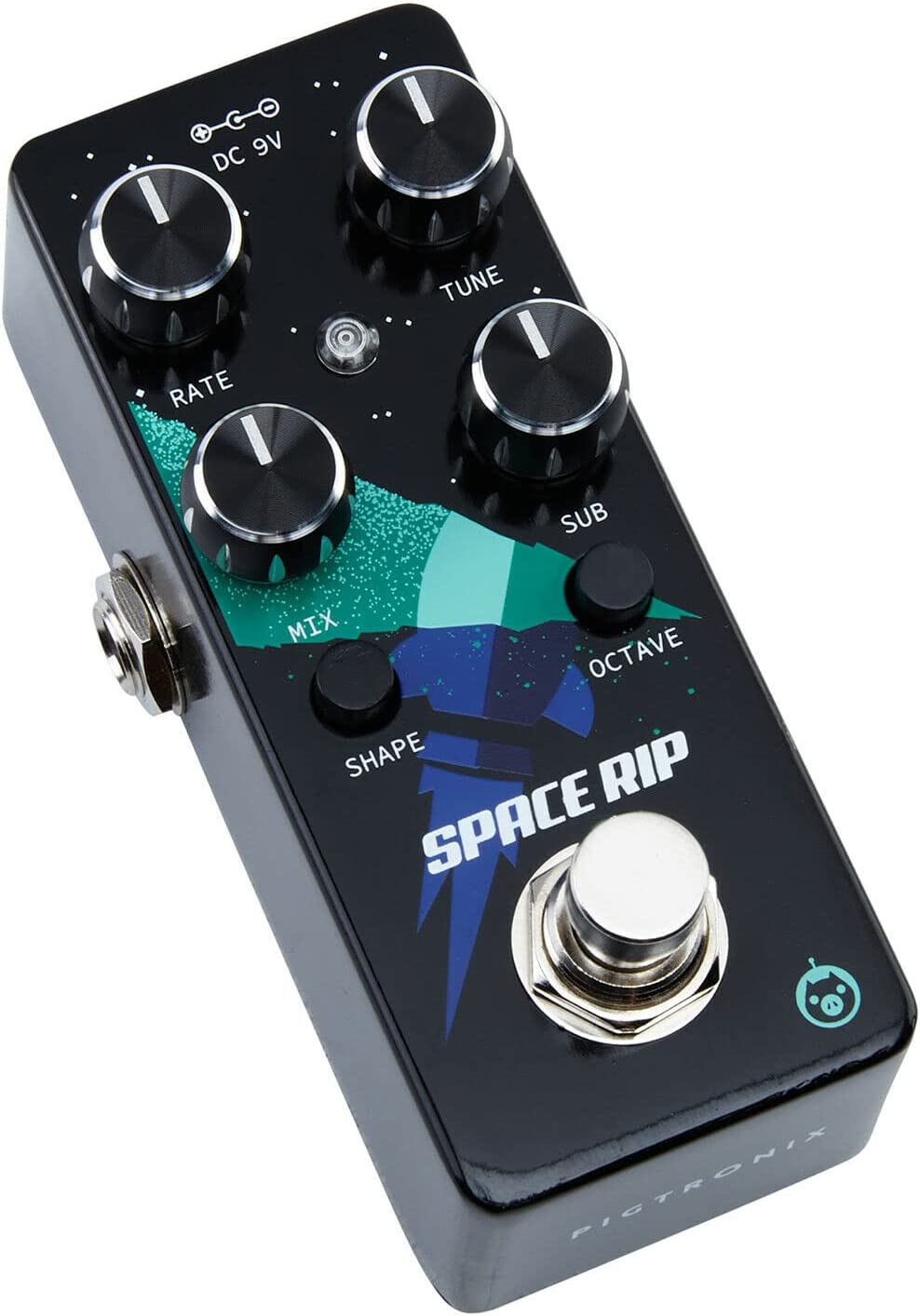
The Pigtronix Space Rip PWM Synth Pedal is more than just a guitar accessory.
This pedal is an ingenious blend of old-school analog sound with cutting-edge tracking technology.
It’s designed for speed, accurately replicating your guitar’s pitch and dynamics no matter how quick your solos are.
Featuring pulse width modulated (PWM) square and sawtooth wave voices across multiple octaves, this pedal is designed to give the bass sound a new depth and dimension.
Its unique controls offer a lot of customization.
You can tinker with the waveform motion’s speed or adjust the synth voices’ fine-tuning.
It also has a Sub knob for an added voice that’s an octave down your input signal.
Or use the Octave switch to plunge the entire synth sound down another octave for earth-shattering bass.
It even allows the waveform to switch from a sawtooth to a square wave and vice versa.
It is designed to run on a standard 9VDC and comes in dimensions of 9 x 6 x 4 inches.
It’s not just a pedal but a mini synthesizer that adds richness to your bass sound.
- My Review
Taking the Pigtronix Space Rip PWM Synth Pedal for a spin, its impressive performance truly stood out.
I was instantly drawn to its classic analog synth sounds paired seamlessly with modern tracking technology.
The impeccable speed of this product was a refreshing experience, with an unwavering accuracy in mirroring both pitch and dynamics.
Playing with its unique features, I could fine-tune adjustments and experiment with the synth voices.
Delving further, I discovered that the Sub knob added an intriguing dimension, infusing an additional voice an octave lower than the input signal.
However, it didn’t stop there.
The entire synth sound descended an additional octave by flipping the Octave switch, making it a bass lover’s delight.
The remarkable pulse width modulation capability allows a choice between square and sawtooth wave voices across distinct octaves.
The dynamic shifting of the waveform motion gave me a thrilling sense of power and control.
The attention to detail in this pedal doesn’t end at its sounds.
Its compact design, taking up a space of just 9 x 6 x 4 inches, is the right balance between utility and mobility.
Yes, it’s run on a standard 9VDC, which didn’t restrict me from taking it on my musical journeys.
However, I wouldn’t say it’s all sunshine and roses.
Perfecting its features can be daunting for beginners, and it might take a while to grasp all the tweaks and customizations.
Here are the ratings I’ll give to the Pigtronix Space Rip Synth Pedal:
So, yes, the Pigtronix Space Rip PWM Synth Pedal is a wonderfully complex toy that rewards patience and time with a masterpiece of sound.
It challenges the norms of a traditional guitar pedal, breaking boundaries and setting new paradigms in the music world.
- Pros:
- Analog sound with modern tracking technology.
- Sub knob and Octave switch enrich bass.
- Compact design makes it portable.
- Cons:
- Complicated features may baffle beginners.
- Requires adaptability to fully utilize.
- Learning curve for optimal customization.
My final verdict is that the Pigtronix Space Rip PWM Synth Pedal is an excellent blend of classic and modern music technology.
While it may seem a bit complex initially, particularly for beginners, the quality and the vast range of features it offers are worth the learning curve.
It’s a gem for those who crave control and customization in their guitar playing, particularly when delving into the realms of bass.
Remember that mastering this tool requires patience and practice, but once you sail through it, the Pigtronix Space Rip can be a game-changer in your musical journey.
EarthQuaker Devices Data Corrupter Pedal
Wild, three-voice synth tones with easy modulation.
The Data Corrupter is a monophonic analog harmonizing PLL with modulation that creates three-voice guitar synthesizer sounds. It amplifies your input signal into a square wave fuzz tone and then modulates it to create a wild yet repeatable sound.
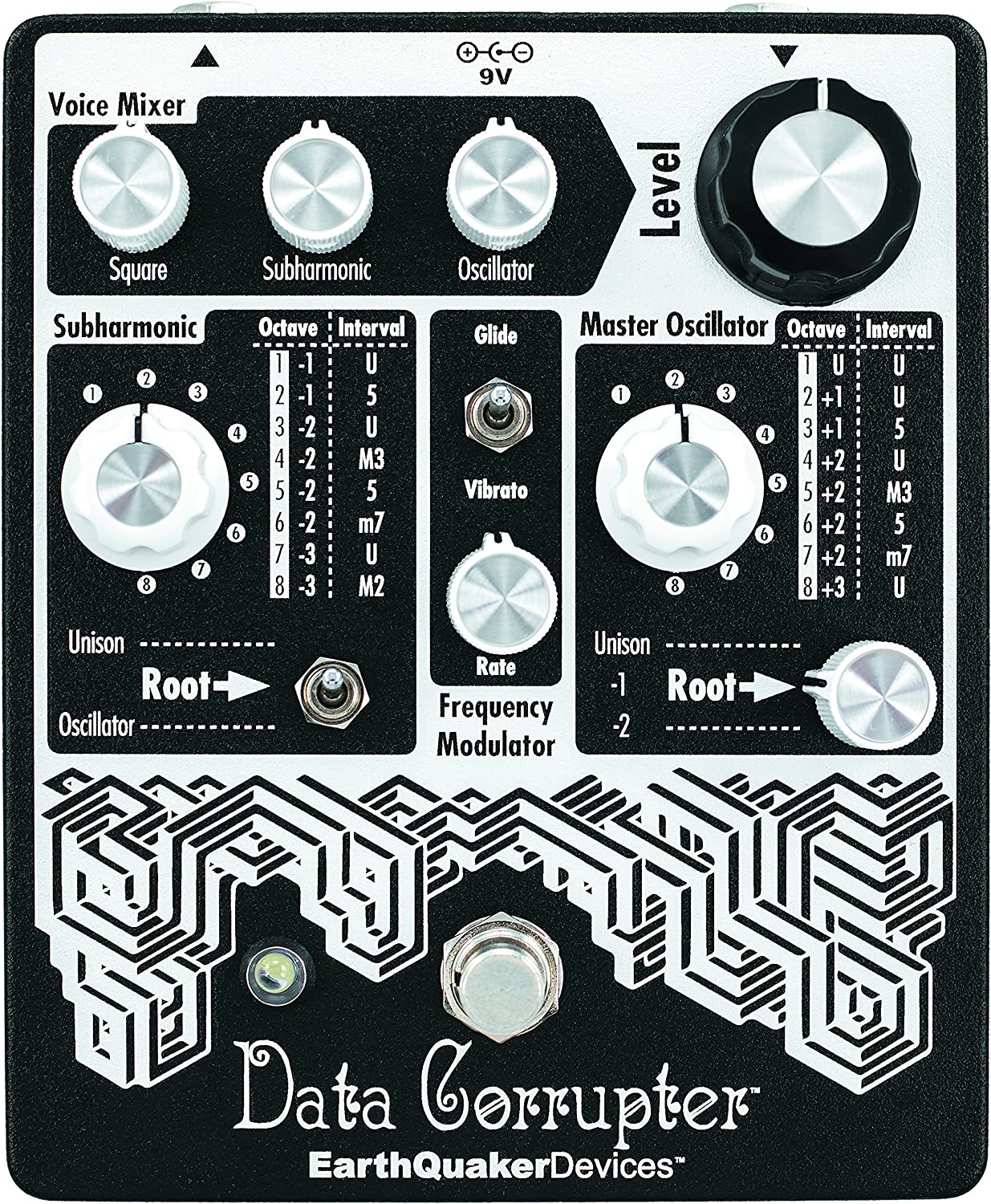
Meet the EarthQuaker Devices Data Corrupter Harmonizing Pedal.
Styled in a visually striking black-and-white color scheme, this compact device measures 6.6 x 5.4 x 3.25 inches.
It weighs a comfortable 1.46 pounds, making it a perfect fit for any electric guitar setup.
This harmonizing pedal goes a notch above the ordinary by producing standout fuzz effects for your guitar.
Crafted for monophonic analog harmonizing, it takes in your input signal.
It intensifies it into a hard-hitting square wave fuzz tone which then undergoes multiplication, division, and modulation, delivering a clear and repeatable three-voice guitar synthesizer.
So, whether you’re plunging into the depths of new sounds or just riffing away on a lazy afternoon, the Data Corrupter’s pedigree in EarthQuaker Devices’ line-up ensures you’re always ready to rock.
Simply put, it’s a mini monster of a versatile device that offers something unique for every guitar maestro.
- My Review
Stepping into my jam session, I quickly realized the unique charm of the EarthQuaker Devices Data Corrupter Harmonizing Pedal.
This pedal is no ordinary fuzz-effect producer.
It’s packed with peculiar abilities that lead you down the rabbit hole of unearthly noises.
Remarkable for its monophonic analog harmonizing, the Data Corrupter devours my input signal, enthusiastically magnifying it into a fierce square wave fuzz tone.
Subsequently, it’s divided, multiplied, and modulated to birth a bizarre yet consistent three-voice guitar synthesizer.
While strumming, I noticed the pedal wasn’t a simple “plug-and-play.” Its distinctive nature compelled me to tweak my notes, forcing me to adapt and grow as I moved along.
It was a curveball throwing multiple pitches, but hitting each one out of the park was a joy!
Regardless of my initial preconceptions, I discovered that the pedal shone when I let it take the lead, writing around its distinctive output rather than imposing my melodies.
Exploring the device, it struck me how each rotation of the oscillator – influenced by my playing speed – transformed my tonal palette.
Its innovative design grants you immense control, allowing for musically colorful and gradient moments.
Of course, it’s not without its quirks.
The lack of a dry output made me yearn for a split within the chain, and while the brilliant concept does take a turn into complete unpredictability, the pedal loses some user-friendliness.
Its build quality inspires confidence, and its aesthetic appeal is undeniable.
But it’s the planet-exploding sounds that this pedal is capable of which truly shines.
Here are the ratings I’ll give to the EarthQuaker Devices Data Corrupter Pedal:
Alien noises and bizarre fuzz effects abound; it’s an invitation to an eccentric sound party.
It may be a wild ride to tame the beast, but if you’re in for synthy, non-conformist soundscapes, the Data Corrupter might be your ticket to the cosmic jam.
- Pros:
- Produces unique and explosive fuzz effects.
- Incredible control over oscillator reactions.
- Sturdy build quality with attractive design.
- Cons:
- Lacks a dry output option.
- Has a steep learning curve.
- Can appear unpredictable at times.
My final verdict is that the EarthQuaker Devices Data Corrupter Harmonizing Pedal is a bold and daring entry into the world of guitar effects.
It’s an invitation to a unique sonic adventure, pushing the boundaries of what a harmonizing pedal can offer.
Despite its challenges and slight unpredictability, it holds a charm that may be irresistible to those intrigued by distinctive sounds and modulations.
Its solid construction and striking design uphold the EarthQuaker brand’s reputation.
This pedal presents an innovative and versatile tool for those up for the challenge, a landscape of musical possibilities that stand out from the crowd.
If you appreciate odd, fuzz-filled novelties, then the Data Corrupter may be worth considering.
Boss SY-300 Advanced Guitar Synth
Unlock expressive new sounds with any guitar via Boss SY-300 Advanced Guitar Synth.
The SY-300 is a revolutionary guitar synthesizer, allowing players to explore new sound dimensions with any guitar via a standard 1/4-inch cable. With powerful polyphonic synthesis, filters, amps, LFOs, and a step sequencer, the SY-300 offers analog-style synth sounds with zero latency and versatile control options. Connect to computers via USB for recording and patch editing.
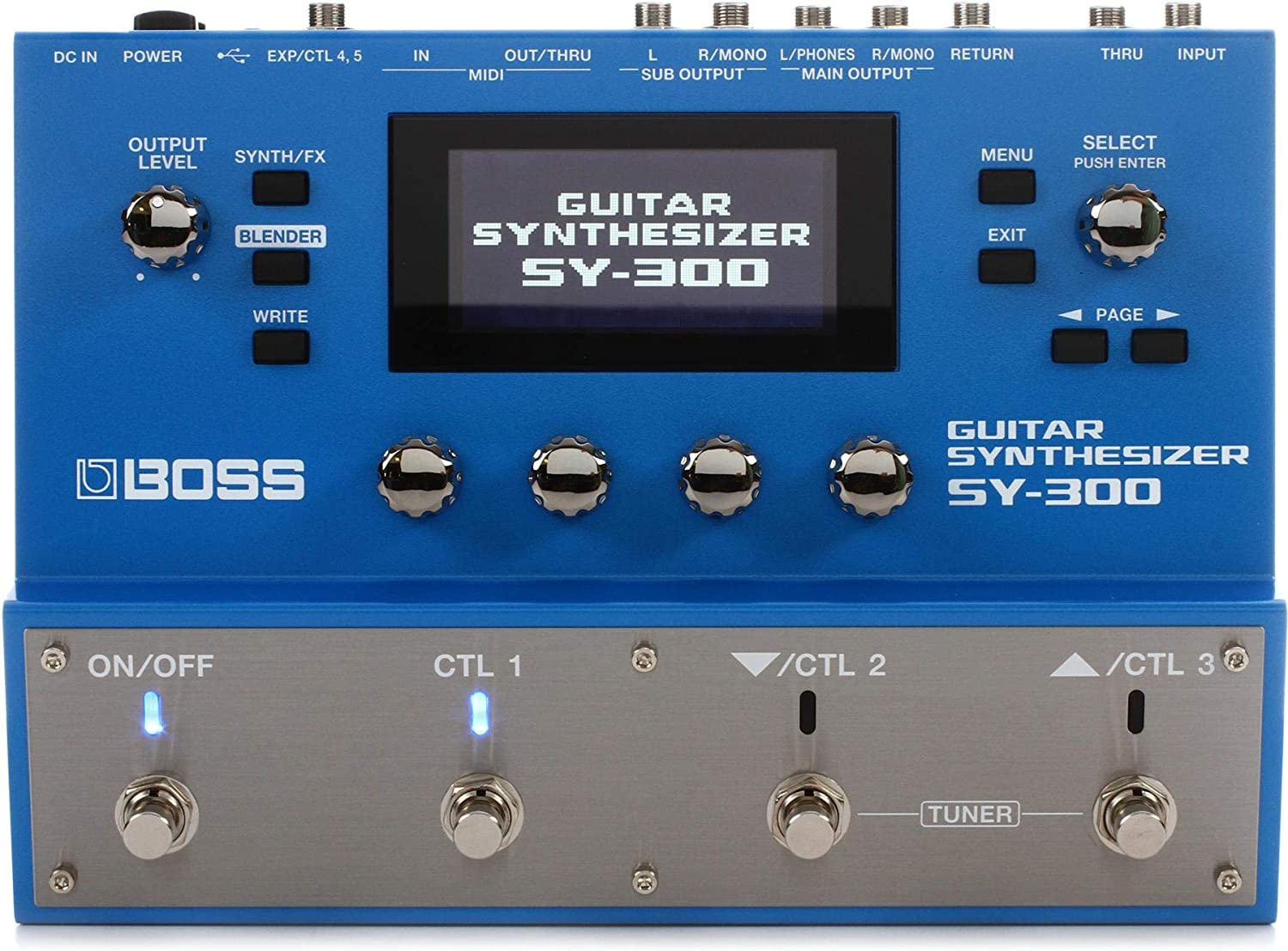
Are you ready to usher in a new world of sound generation with your guitar?
Meet the Boss SY-300 Advanced Guitar Synth.
This versatile system, designed for electric guitar, enables you to enjoy a rich spectrum of polyphonic synth sounds, all courtesy of BOSS’s revolutionary technology.
You can access these sounds without the need for any special pickup.
Just connect your guitar, and voila, a world of sounds at your fingertips.
The Boss SY-300 goes beyond simply altering your guitar sound.
Its built-in filters, amps, and LFOs let you play around to discover uncharted territories of rich soundscapes.
Moreover, it offers plug-and-play convenience with zero latency for a seamless extension of your instrument’s natural feel.
This powerful synth also sports various features like a step sequencer, a Blender function for mixing synth settings, and extensive connectivity options, including USB and MIDI.
The SY-300 is indeed every guitarist’s dream, bringing new dimensions of creativity right under your fingers.
Another great thing about this guitar synth is its physical dimensions and weight, keeping it compact and comfy for any guitar setup, and yes, it comes in a cool blue color!
- My Review
Diving into the world of the Boss SY-300 Advanced Guitar Synth was like opening the door to boundless sonic possibilities.
This compact, cobalt-blue beauty, so easy to connect with a standard 1/4″ input, effortlessly turned my trusty axe into a full-blown synthesizer – no special pickup required.
Instantly, I felt creativity surge, aided by the zero-latency claim living up to its promise, keeping my guitar’s natural expressiveness undisturbed.
I could mold my sound using this synth’s filters, amps, and LFOs. The result?
A delightful assortment of fantastic soundscapes I’d never imagined before.
Probing further into the labyrinth of sounds offered by the SY-300, my senses were flooded with rich, polyphonic, analog-style synth sounds.
These were not just mere alterations.
They were transformations, extending the guitar’s usual realm into uncharted architectural wonders of sound.
The system wasn’t without complexities, though.
This is a machine that commands your time.
But the rewards are well worth the investment.
As I began exploring features like its step sequencer and Blender function for mixing synth settings, I realized the depths of its sound-crafting capabilities.
The extensive connectivity options also caught my eye.
From the dual output pairs and the versatility of MIDI In and Out /Thru jacks to the usefulness of its USB interface for the digital age, the SY- overall-300 provides incredible potential for integration with other gears.
On the downside, not all the presets were practical for real-world musical scenarios, leaning more towards the experimental side.
Yet, this limitation didn’t put a damper on my experience.
If anything, it added a touch of eagerness for exploration and personal customization, opening avenues for creativity.
My time with the SY-300 was more than just reviewing a product.
Here are the ratings I’ll give to the Boss SY-300 Advanced Guitar Synth:
It was a journey through sonic landscapes.
It’s an impressive feat of technology, a testament to Boss’s mastery in their field, making it an exciting addition to a guitarist’s arsenal.
- Pros:
- No special pickup installation required.
- Abundance of creative synth sounds.
- Extensive connectivity options.
- Cons:
- Unpractical presets for some genres.
- Complexities require deep exploration.
- Some unconvincing sound reproductions.
My final verdict is that the Boss SY-300 Advanced Guitar Synth is a groundbreaking product with an impressive capacity for sonic transformation that is worth exploring, especially for those who crave creative versatility.
Its slight complexity and ambitious presets may be challenging for some, but they also provide a fertile ground for innovation and personal customization.
Great value in the realm of guitar synthesis.
What exactly is a synth pedal?
Synthesizers or synth pedals are a type of stompbox or effects unit that guitarists or other musicians use to alter the sound of their instruments in ways that mimic the sounds produced by synthesizers.
This is done by modifying the signal from the instrument in various ways, such as by changing the signal’s amplitude, frequency, or phase.
Traditional synthesizers are keyboards that generate signals electronically, which are then modified to create different sounds.
A synth pedal allows guitarists to access similar sound-altering capabilities without requiring a keyboard-based synthesizer.
The concept of pedals for musical instruments has been introduced previously.
However, the synth pedal is a different beast altogether.
The synth pedal is a complex but beautiful tool that can transform a simple guitar into a complicated synthesizer.
Synth pedals come in a wide variety of styles and capabilities.
Some are relatively simple and provide just a few different synth sounds, while others are more complex and offer a wide array of controls and options for fine-tuning the sound.
The key component is that these pedals produce a synthesized tone that alters the original guitar tone, turning the guitar effectively into a synthesizer.
At the core of many synth pedals is a technology called ‘oscillation.’ An oscillator generates a steady, periodic waveform at a specific frequency, a simple geometric shape such as a sine, square, or triangle wave.
This waveform serves as the raw material for the synthesized sound.
Many synth pedals allow this base waveform to be altered in several ways, including changing the frequency (pitch), amplitude (volume), and harmonic content (timbre).

This results in various possible sounds, from simple tones to complex, layered sounds.
In terms of inner workings, a synth pedal uses a special circuitry named a synthesizer engine.
As a guitar player hits a note, the guitar pickup senses the strings’ vibrations.
It converts these vibrations into an electrical signal, then routes them to the synthesizer engine in the pedal.
The pedal transforms this input signal through ‘wave shaping’ to generate the final synthesized sound.
It’s important to note that although a synth pedal imitates the sound and function of a keyboard synthesizer, it doesn’t provide the same extensive control over the generated sound.
A synth pedal typically has fewer parameters for tweaking, and matching a specific synthesizer sound can be challenging.
However, the beauty of a synth pedal lies in its ability to provide the unique, experimental sounds of a synth while being played on a familiar instrument like a guitar.
Synth pedals enable guitarists to expand their musical horizons and experiment with new sounds and textures that wouldn’t be possible with a traditional guitar setup.
Some synth pedals are ‘monophonic,’ meaning they can produce one note simultaneously.
Others are ‘polyphonic,’ allowing them to generate multiple notes simultaneously.
Many modern synth pedals also include built-in effects like reverb, distortion, and delay, which can be used to modify the synthesized sound further.
The connectivity and compatibility aspect plays a significant role too.
Modern synth pedals can connect with computers via MIDI or USB, providing even more sound-shaping possibilities.
This connectivity feature makes them an excellent tool for music production and recording.
The beauty of synth pedals is how they enable guitarists and other musicians to incorporate synthesized sounds into their music without learning a new instrument.
Instead, they can continue using their existing musical skills and techniques while exploring a new world of sound.
Various brands in the market offering varied types of synth pedals, like Boss, Electro-Harmonix, and Digitech, each with unique features and sound gradients.
What to consider when choosing a synth pedal?
Choosing a synth pedal is important for musicians, particularly for guitarists and bassists looking to broaden their sonic palette.
Whether new to synthesizers or a seasoned pro, a synth pedal can significantly impact your tone and the type of music you create.
While the market offers various options, selecting the right one can take time and effort.
However, you can make an informed decision with proper guidance and understanding.
– Sound Quality
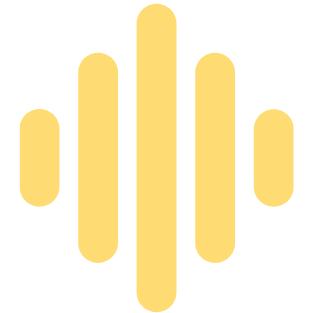
Sound quality undeniably emerges as the critical factor every musician should consider when looking for a synth pedal.
It is the cardinal condition for assessing the overall effectiveness of a music device.
A high-end effect pedal is expected to reproduce high-quality sound that closely mirrors the original tone.
It should manage to do this without aggregating noise or impacting the native sound’s clarity and purity.
This quality can either enhance or significantly take away from a sound performance.
The best way to evaluate the quality of sound a pedal can offer is by listening to a sound demo of the pedal online.
Alternatively, you can visit your local music store for an in-person experience with the device before you decide on your purchase.
This preliminary run-through will help determine whether the pedal can yield the synth sound you aim to create.
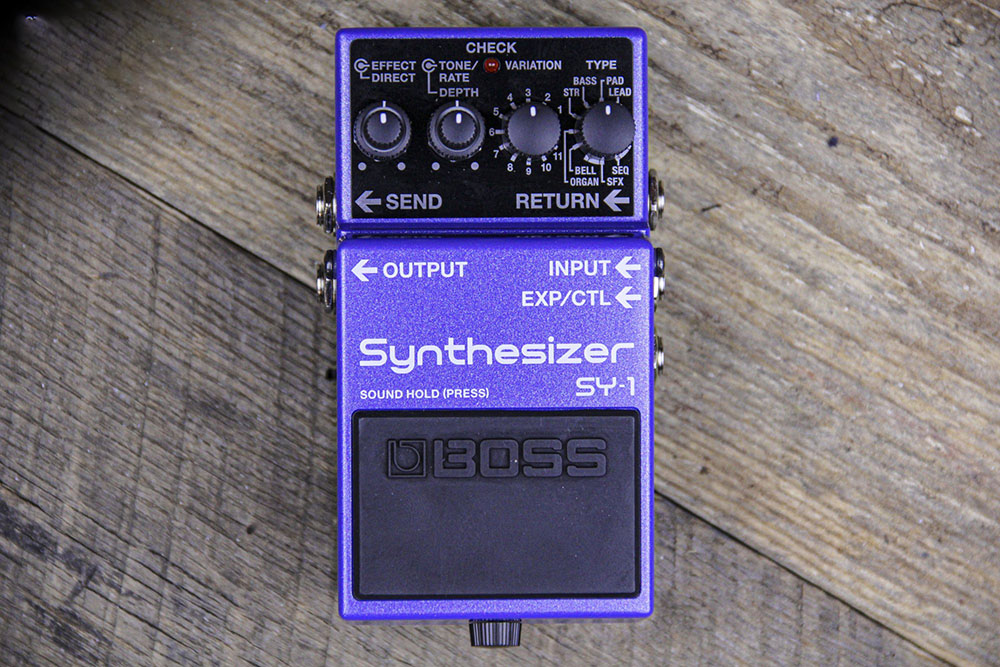
Indeed, such sounds could include monophonic, polyphonic, wavetable, granular, or additive synthesis.
A quality synth pedal should guarantee a seamless tracking response and exceptional balance in tone.
Moreover, the pedal should generate minimal noise that does not interfere with your music.
Thus, it’s not just about generating sound but the sound quality it makes that defines a good synth pedal.
– Controls & features
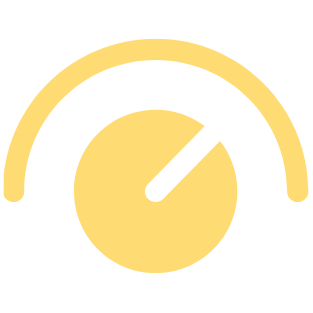
Selecting one with user-friendly controls and features is crucial when opting for a synth pedal.
This would provide the invaluable ability to experiment and explore various synth sounds.
The input and output controls are among the essential functions that your synth pedal should possess.
These features allow easy modulation of sound entry and exit, thus playing a significant role in sound production.
Envelope filters are another essential feature, as they allow you to adjust the frequency characteristics of the sound, thus expanding your sonic palette.
Modulation effects offer an avenue to add depth and movement to your sound, while oscillator types provide the core sound the synth generates.
The synth pedal should also have other sound-shaping abilities that offer a wide range as you navigate your sound design journey.
Features that could prove to be useful include an expression pedal input.
This feature would offer real-time control of varying effects parameters, allowing for on-the-go tweaks during performances.
MIDI integration is another important attribute to sync your synth pedal with other devices.
Built-in tuners can aid in maintaining the quality of your sound, whereas a loop function might offer additional creative possibilities.
The bypass mode is another useful feature, allowing you to turn the synth effect off while permitting other effects to work.
Ensuring that the synth pedal offers an efficient way to access and tweak these features is paramount.
Such a feature would be particularly vital during live performances, where quick adjustments are often necessary.
– Analog vs. digital
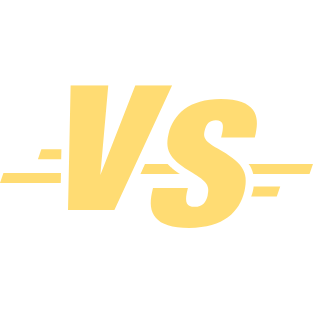
When it comes to the consideration of synthesizer pedals, the debate between analog and digital plays a crucial role.
Analog pedals, which utilize electronic circuits to produce synthesizer sounds, are renowned for their warm, richly harmonic tones.
On the other hand, you have digital pedals which employ digital signal processing technology to generate a broad spectrum of synthesizer sounds.
Those who consider themselves synth purists often hold the unique character and warmth distinctive of analog pedals in high regard.
These pedals give musicians a sense of authenticity that their digital counterparts cannot match.
A certain intrinsic quality of analog signals offers a raw, driving sound that is perceived to be richer and fuller than the outputs of digital synthesizer pedals.
Nevertheless, digital pedals have their unique advantages.

These units offer greater flexibility and convenience, making them appealing to a different set of musicians.
They come with options that allow users to save their preferred settings and recall presets quickly, ensuring consistent performance quality.
This doesn’t just simplify usage; it enables various sound options that give an artist’s music a versatile edge.
Therefore, choosing between analog and digital pedals should be a decision based on a musician’s preference for sound quality combined with versatility considerations.
Each musician should explore both options, distinguish the differences, and consider the benefits, to find the type that aligns with their musical needs and aspirations.
Ultimately, it’s a personal choice that will greatly influence the development of their unique sound.
– Build quality & durability

A well-constructed, durable pedal can withstand repeated stomping and usage, making it a worthwhile investment.
Look at the build material of the pedal; it should be of robust construction to endure the rigors of live performances and constant travel.
Furthermore, the knobs and switches should offer a comfortable grip and smooth operation without feeling wobbly or loose.
Consider the thickness and durability of the cords or connectors that come with the pedal; they play a critical role in its overall resilience.
A well-built pedal will generally have sturdy, thick cables that can handle rough usage.
The longevity of the pedal will also depend on various other elements, like the quality of the internal components and the craftsmanship involved in assembling the pedal.
The pedal’s footing should be strong and stable on any surface, ensuring that it does not shift or move unexpectedly during a performance.
The internal wiring and circuitry must also be of exceptional quality to ensure a long life span.
If any part of the pedal is made from cheap materials, it will definitely affect the durability.
Therefore, when shopping for a pedal, build quality and durability should be one of your top considerations, as this will impact performance, reliability, and lifespan.
The greatest pedals are those that can withstand the test of time, use, and travel.
– Presets & versatility

One key aspect that truly increases a synth pedal’s convenience and usability is the inclusion of presets.
These presets let you save the settings you prefer and provide immediate access whenever needed.
The ability to save these presets significantly improves in real-time sessions, particularly during live performances where swift shifts between different settings are often necessary.
The fluid transition achieved using presets allows you to maintain the rhythm and flow of the piece without unnecessary interruptions caused by manual adjustments.
Synth pedals that offer a wider array of versatility typically come with more presets.
This allows you to access various sound options and music styles simply with a button.

This kind of freedom in sound design and music style allows musicians to be daring in crafting their unique sound while also maintaining the consistency of their tone.
These feature-loaded synth pedals can be invaluable tools for those looking to explore diverse audio landscapes and experiment with an extensive sound spectrum.
Thus, besides contributing to usability and convenience, the presets add an element of exploratory fun, widening the horizon of creativity for musicians.
– Brand reputation

When considering a purchase, it’s important to consider the brand’s reputation behind the product.
Brands that have a reputation for being well-known and trusted typically offer products that are of high quality and reliability.
This is because they are vested in maintaining good standing within the market.
As a result, they often ensure that their products undergo a rigorous testing process before being released for sale, ensuring they live up to the consumers’ expectations.
Another critical element associated with a brand’s reputation is its customer service.
Companies with a strong reputation often have excellent customer service, meaning any arising issues or concerns are likely to be handled swiftly and effectively.
This adds a layer of assurance for prospective buyers as they can expect to be supported throughout their product’s life cycle.
Therefore, it’s highly recommended that before making a purchase, potential buyers should thoroughly research the history and current standing of the company producing the product.
By doing so, they will gain a clearer insight into the likely quality of the product and can hence make a more informed decision.
For instance, if you’re buying a guitar pedal, delving a little into the producer’s background and reputation can give you a clearer idea about what to expect from the product regarding its quality and reliability.
– Price & budget
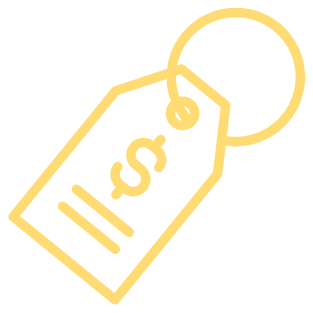
The cost of synth pedals fluctuates considerably due to variations in brands, models, features, and quality, ranging from easily affordable budget options to some of the more high-end, luxury boutique models.
It’s always beneficial to have an outline of your budget in mind before making a purchase.
However, it’s also vital to remember that a higher price tag doesn’t necessarily guarantee a higher quality or a better product.
Like purchasing any other equipment, it’s most crucial to understand and balance the cost angle against the kind of features you’re seeking, the level of quality you require, and how frequently you will use it.

As synth pedals represent a significant investment, ensuring your budget aligns with your needs can help you make a smart purchase.
Your best bet is to assess your specific needs, do some research to determine a budget, and then find the best synth pedal that fits inside those parameters.
– Reviews & recommendations

Before making your purchase, do thorough research.
User reviews, forum discussions, and expert recommendations can provide valuable insights into a synth pedal’s real-world performance.
Look for consistent praise or critiques about a certain feature or characteristic.
Recommendations from professional musicians, music teachers, or trusted friends in the music world can also be beneficial.
How to properly use a synth pedal?
Understanding how to use a synth pedal properly can elevate your sound and create unique audio experiences.
From setting up the device to utilizing its various features, we’re here to guide you every step of the way.
– Familiarize yourself with the controls and features
Using a synth pedal effectively starts with a deep understanding of what it can do and how its settings alter the sound.
Familiarize yourself with features such as wave shapes, oscillator settings, modulation controls, and synthesis parameters.
Wave shapes control the sound’s basic character, and oscillators generate the sound wave itself.
Meanwhile, modulation controls like LFO (Low-Frequency Oscillator) and envelope parameters allow modification to the wave shapes, thus altering the resulting sound’s texture and movement.
Understanding these controls is crucial for achieving the desired sound.
Synth pedals may include options like polyphonic settings, allowing multiple notes to play simultaneously, and predefined instruments or sounds, such as organs, strings, or brass effects.
Some pedals might offer more experimental features, including ring modulator or bit-crusher effects to craft unique, otherworldly sounds.
An essential feature to be aware of is the bypass switch that engages or disengages the pedal effect when you press it.
It is worth noting that some pedals offer true bypass, which means the signal from your guitar passes straight through the pedal when the effect is switched off, offering a cleaner, unaltered tone.
– Adjust the parameters to suit your musical goals
Once comfortable with your synth pedal’s capabilities, you can experiment with the settings to achieve various sounds.
The best way to do this is by making minor adjustments one at a time, listening carefully to how the changes affect the sound, and making notes of those settings you like.
For instance, if you aim for an organ sound, you might start by selecting a sine or triangle wave shape, ensuring the pedal is in monophonic mode, and using a longer attack on the envelope for a smooth, swelling sound.
You may opt for a sawtooth wave with a shorter attack for brassy sounds.
Remember that there are no hard and fast rules for these adjustments.
Music is an art form where creativity is paramount.
So, feel free to experiment and venture beyond traditional settings.
– Incorporate the synth pedal into your signal chain
After getting a good grasp of the controls and settings, the next step is integrating the synth pedal into your existing guitar setup or ‘pedalboard.’
The placement of pedals in the signal chain plays a significant role in shaping the overall sound.
Most guitarists put their synth pedal at the front of the signal chain, allowing the raw, unprocessed guitar signal to enter the pedal first.
Placing the synth pedal early in the chain helps it effectively track the guitar’s signal, giving a clearer, more defined synth sound.
However, the pedal order can create different sounds, so you may want to experiment and find what works best for your style.
– Test and adjust connection:
After incorporating the synth pedal into your signal chain, it’s crucial to ensure it is connected correctly to work optimally.
Start by plugging your guitar into the synth pedal and subsequently connect it to the amplifier.
Ensure that all the connections are secure and that there are no loose or damaged wires, as these may affect sound quality.
Next, thoroughly inspect all your patch cables – these lifelines transmit the signal from your guitar through the pedal to the amplifier.
Quality, well-maintained patch cables can significantly enhance your connection’s sound quality and reliability.
Thus, you should test them for sound transmission and meticulously check for wear and tear.
Consider replacing any cable that has been damaged, as it may cause signal loss, excessive noise, or introduce unwanted sound artifacts.
As you test your setup, pay close attention to the sound your pedal produces.
Is there any signal loss? Do you notice any unusual noise or hum?
Such issues indicate a poor connection or a faulty cable.
Therefore, take the time to resolve these problems before proceeding.
You should tighten the jacks, replace faulty cables, or even rectify an issue with the pedal’s power supply.
Also, keep in mind that synth pedals can be demanding, particularly when it comes to tracking the pitch of the guitar.
Synth pedals analyze the frequency of your guitar’s signal to generate their sounds, which can be a complex task.
This complexity can sometimes lead to lag or inconsistency in the synth sound.
To address this, you may need to adjust the pedal settings or your playing technique.
For example, playing with a strong and clear attack can help the pedal accurately detect pitch.
It’s best to experiment and make the necessary changes until you reach the sound quality you desire, free of any latency or inconsistencies.
– Fine-tuning the effects
After successfully incorporating the synth pedal into your existing rig and ensuring all the necessary connections are functioning perfectly, it is crucial to dedicate some time to fine-tune the effects.
This step becomes particularly important as it significantly influences the shape and sound of your musical production.
Listen carefully to the sound produced when you engage the pedal.
Sound check should always be your point of reference in this exploration, as minor adjustments in the pedal’s settings can create substantial alterations in the resulting sound.
You can experiment by tweaking various parameters.
For instance, adjusting the levels of attack and release changes the duration of the sound, while morphing wave shapes and refining oscillator configurations allows you to sculpt and color your sound, moving it closer to your desired musical outcome.
Furthermore, consider that the synth pedal does not operate in isolation; instead, it interacts with your playing style and the unique characteristics of your instrument.
Your strumming or plucking dynamics can greatly influence how the pedal responds and shapes the sound.
Guitar volume also plays a key role, as it affects the gain structure entering the pedal and determines the heaviness or lightness of the output.
Your pick choice can also create differences in sound, with heavier picks generally providing a stronger signal for the pedal to track.
Even the type of strings on your guitar can impact how well the pedal performs, with newer, brighter strings offering better tracking accuracy.
In summary, the fine-tuning process of a synth pedal involves a careful balance of parameter adjustment and understanding how the pedal responds to your unique playing style and instrument’s characteristics.
– Practice playing
Like any aspect of playing an instrument, effectively using a synth pedal requires practice.
Experiment with different techniques and play around with the settings.
Use it while practicing scales, chords, or riffs to deepen your understanding of how it can enhance or alter your sound.
Also, consider how the synth pedal can be utilized as a live performance tool.
From creating atmospheric soundscapes to doubling your lead lines, the ease of use during a performance will significantly depend on how well you’ve mastered the pedal during practice.
– Incorporating into performance
Finally, the pedal is meant to be a creative tool for expressing your musical ideas in live performances and recording sessions.
In the context of a band performance, it can cut through the mix or provide different textures to the band’s soundscape.
It’s important to be independent of the effect but to use it as a tool to enhance your musical creativity.
How to order pedals on a pedalboard?
There is no one-size-fits-all approach to ordering pedals on a pedalboard, as the optimal arrangement largely depends on the specific sound you’re aiming for.
Usually, though, you will see guitar players mostly agreeing with this order:
Tuner > Filters/Dynamics > Pitch-based Effects > Overdrive/Distortion > Modulation > Time-based Effects > Looper
Aside from that, some general guidelines can help you achieve a balanced and versatile setup.
Let’s talk in detail about the order we just mentioned, but feel free to experiment and adjust to your own preferences:
- Tuner: Place your tuner pedal first to ensure your signal is in tune before passing through the other pedals.
- Filters and dynamics: Wah-wah, envelope filters, compressors, EQs, and noise gates should come next. These pedals affect your sound’s dynamic and tonal aspects, so it’s best to place them early in the chain.
- Pitch-based effects: Octavers, harmonizers, and pitch shifters should come after filters and dynamics since these pedals alter the pitch of your signal and work best with a clean, unprocessed sound.
- Overdrive and distortion: Overdrive, distortion, and fuzz pedals typically come next. They shape your guitar’s core sound, and placing them before most other effects ensures that those effects receive a strong, consistent signal.
- Modulation effects: Chorus, flanger, phaser, and tremolo pedals should be placed after overdrive and distortion effects. We do this to allow these pedals to add depth and movement to your sound without becoming overly distorted or overbearing.
- Time-based effects: Delay and reverb pedals should be placed towards the end of your signal chain. This allows them to create a sense of space and depth around the other effects, simulating the sound of a room or hall.
- Looper: If you use a looper pedal, it should be placed last in the chain. This ensures that you’re looping the entire signal, including all the effects you’ve applied.
Remember, these are just general guidelines and what generally works and sounds good.
The most important thing is to experiment and find the arrangement that best suits your personal sound and style.
For example, here’s one pedalboard signal chain that I always use:
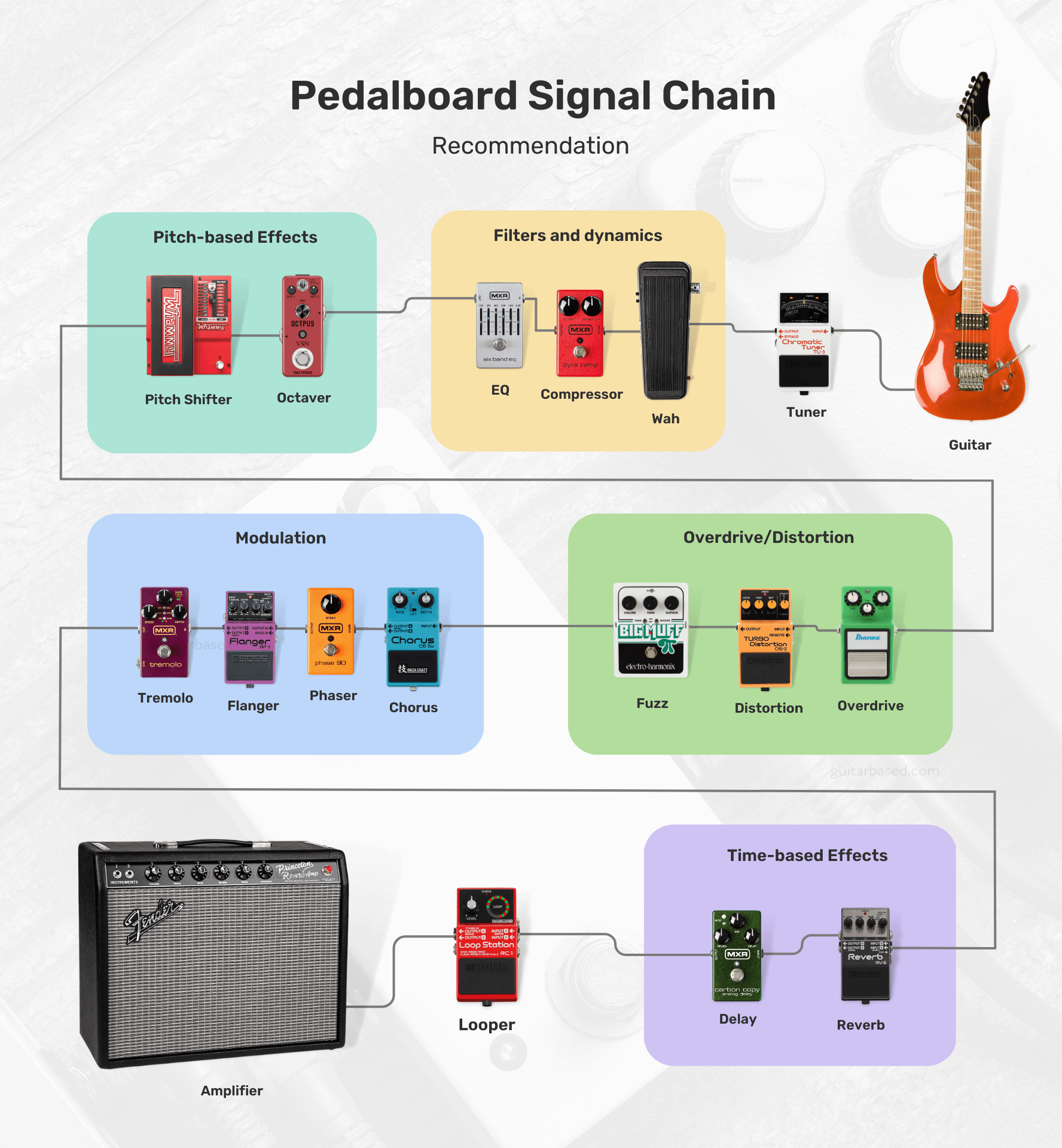
Feel free to swap the order of pedals, try different combinations, and test out unconventional setups until you find the one that works best for you.
For those interested, I’ll leave you with most of the possibilities that you’ll encounter and how to order them.
- Tuner
- Filters/Dynamics:
- Volume
- Wah
- Auto-Wah
- Compressor
- Noise Gate
- EQ (Equalizer)
- Pitch-based Effects:
- Octaver
- Harmonizer
- Pitch Shifter
- Overdrive/Distortion/Fuzz:
- Boost
- Overdrive
- Distortion
- Fuzz
- Modulation:
- Chorus
- Phaser
- Flanger
- Univibe
- Vibrato
- Tremolo
- Time-based Effects:
- Delay
- Echo
- Reverb
- Synth/Bitcrusher:
- Synth
- Bitcrusher
- Acoustic Simulator
- Multi-Effects
- Utility:
- Buffer
- A/B/Y Switcher
- MIDI Controllers
- Looper
Boutique vs. Mass-Produced pedals
Boutique pedals are generally built with higher-quality components and craftsmanship, resulting in better durability and longevity.
These pedals often feature unique and innovative designs, providing a wider range of tones and effects that may not be available in mass-produced options.
Here are a few examples of boutique pedals:

All the manufacturers also tend to have a more personal approach, with better customer service and the ability to customize pedals according to the user’s preferences.
However, boutique pedals are usually more expensive due to the smaller scale of production and the use of premium components.
Mass-produced pedals, on the other hand, are more affordable due to their larger scale of production and the use of cost-effective components.
These pedals are widely available and offer a range of popular effects, making them accessible to a larger audience.
Here are a few examples of mass-produced pedals:

The quality control for mass-produced pedals can vary depending on the brand and model, but many are reliable and offer good value for the money.
As for one of the downsides, you’ll find that mass-produced pedals may not have the same level of uniqueness or innovation as boutique options.
On the other hand, they may not provide the same level of customer service or customization options.
The choice between boutique and mass-produced pedals depends on your personal preferences, budget, and desired sound.
If you’re looking for unique tones, higher-quality components, and a more personal experience, boutique pedals may be the way to go.
But I would say, for those who are on a budget and need access to popular effects, mass-produced pedals might be a better fit.
It’s worth trying out both types to see which best suits your needs and playing style.
How much should you spend on a guitar pedal?
If I were in your position, I would first determine my budget and specific needs before deciding how much to spend on a guitar pedal.
For beginners, it might be more reasonable to start with affordable, mass-produced pedals to explore different effects without spending too much.
Guitar pedals can range in price from around $30 to over $400, depending on the brand, quality, and complexity of the effect.
As your skills and understanding of your preferred tone develop, you can gradually upgrade to higher-quality or boutique pedals.
One thing I would do is consider which effects are essential to your playing style and prioritize purchasing those first.
Allocating a larger portion of your budget to the most important pedals might be a wise choice, especially if you only need a few basic effects.
However, if you require a wide array of effects, you may want to consider more budget-friendly options or multi-effects units.
Keep in mind that higher-priced pedals often come with better build quality, unique features, and improved sound quality.
But I would also say that price is not always directly correlated with quality or suitability for your needs.
Sometimes, a more affordable pedal can deliver the exact sound you’re looking for, while a higher-priced option might not meet your expectations and are only expensive because of the brand reputation.
Can you use a guitar pedal with a bass guitar?
You can certainly use a guitar pedal with a bass guitar.
But it’s crucial to be aware that some guitar pedals may not be specifically designed to accommodate the frequency range of a bass guitar.
This could result in a less-than-ideal performance or an altered tone that might not be what you were expecting.
If you’re feeling adventurous and eager to experiment with your sound, don’t hesitate to connect your guitar pedals to your bass guitar.
This can be a fun way to explore different sonic possibilities, and you might even stumble upon some unique tones that complement your playing style perfectly.
Using a guitar pedal with a bass guitar may not always produce the desired results.
In some cases, the low-end frequencies might be lost, or the effect could sound too harsh or muddy.
To avoid these issues, you could consider looking into pedals that are specifically designed for bass guitars.
These pedals are engineered with the bass frequency range in mind, ensuring that your low-end remains intact and the effect sounds as intended.
In addition to bass-specific pedals, there are also multi-effects processors and pedals that cater to both guitar and bass players, offering a wide range of effects and tonal options.
These versatile units can be a great solution if you play both instruments and want a single device to cover your needs.
How to properly power your pedals?
When it comes to powering your pedals, you want to make sure you’re doing it right to avoid any noise issues or potential damage.
First, check each pedal’s power requirements, which you can usually find in the manual or on the pedal itself.
You’ll want to pay attention to the voltage (usually 9V, 12V, or 18V) and current (measured in milliamps or mA).
Now, you’ve got a few options for powering your pedals.
You can use individual power supplies or batteries for each pedal, but that can get messy and inconvenient.
I’d recommend going for a pedal power supply or an isolated power brick.

For example here are a few ones I recommend:
- Voodoo Lab Pedal Power 2 Plus Isolated Power Supply (My favorite)
- Rowin PW-1 Guitar Pedal Power Supply (Cheapest)
These babies can power multiple pedals at once, and the isolated outputs help prevent noise and ground loop issues.
Just make sure the power supply you choose can handle the voltage and current requirements of all your pedals.
When you’re connecting everything, use good quality power cables and keep them neat and tidy to avoid a tangled mess.
You might even want to use cable ties or cable organizers to keep everything in order.
In love with guitars, and gear; expert in all things music! Been writing about guitars for about 5 years and counting. Born in the ’90s. Alma Mater: University of Havana. Always curious, trying to understand the world. #TeamFender

